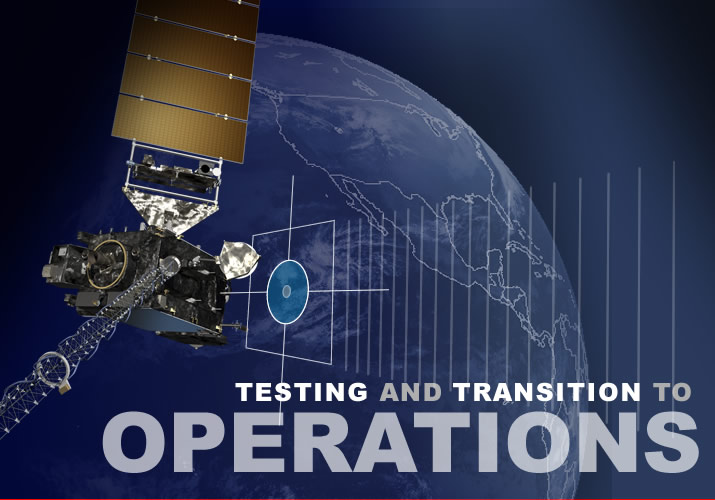LIVE LAUNCH COVERAGE
NOTE: the following links in general carry mixed agency content until launch day/time.
RELATED CONTENT
The GOES-T launch window on January 8, 2022 is open XX:YY – AA:BB EDT.

GOES-R/GeoXO Quarterly Newsletter
Issue 47, 4th Quarter 2024
The latest GOES-R/GeoXO quarterly newsletter is now
available.

In 2025, NOAA is celebrating 50 years of its heralded GOES satellite program
For five decades, NOAA and NASA have partnered to advance NOAA satellite observations from geostationary orbit
Watch Video GOES 50th Web Page
NOAA Releases Initial Imagery from the GOES-19 Lightning Mapper
The GOES-19 GLM is now continuously observing lightning over the Western Hemisphere.
Feature Story
NOAA Debuts First Imagery from GOES-19
On Sept. 18, 2024, NOAA shared the first images of the Western Hemisphere from its GOES-19 satellite.
Feature Story
Earth from Orbit
This new video series features significant weather events and environmental hazards, as seen by NOAA satellites.

Images:
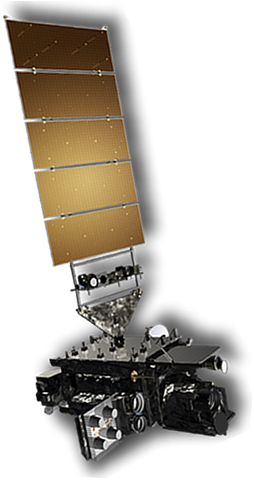
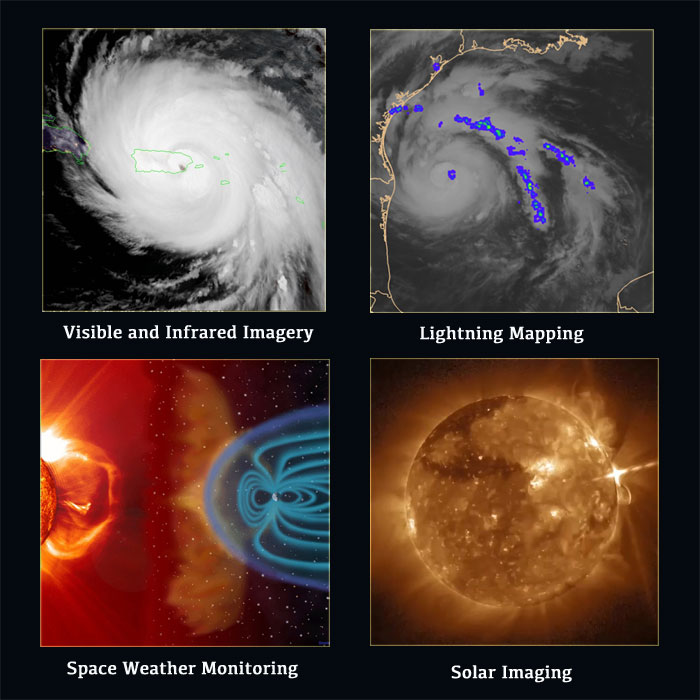
NOAA's latest generation of geostationary weather satellites
The Geostationary Operational Environmental Satellite (GOES) – R Series is the nation’s most advanced fleet of geostationary weather satellites. The GOES-R Series significantly improves the detection and observation of environmental phenomena that directly affect public safety, protection of property and our nation’s economic health and prosperity.
The satellites provide advanced imaging with increased spatial resolution and faster coverage for more accurate forecasts, real-time mapping of lightning activity, and improved monitoring of solar activity and space weather.
The GOES-R Series is a four-satellite program (GOES-R/S/T/U) that will extend the availability of the operational GOES satellite system through 2036.
- Improved hurricane track and intensity forecasts
- Increased thunderstorm and tornado warning lead time
- Earlier warning of ground lightning strike hazards
- Better detection of heavy rainfall and flash flooding risks
- Improved transportation safety and aviation route planning
- Improved detection of low cloud/fog
- Improved air quality warnings and alerts
- Better fire detection and intensity estimation
- Improved solar flare warnings for communications and navigation disruptions
- More accurate monitoring of energetic particles responsible for radiation hazards to humans and spacecraft
- Better monitoring of space weather to improve geomagnetic storm forecasting
Remote environmental sensing is only part of the GOES-R Series mission. The satellites also provide unique capabilities to relay data directly to users to meet critical needs
Data Collection System (DCS)
DCS is a satellite relay system used to collect information from Earth-based data collection platforms that transmit in-situ environmental sensor data from more than 20,000 platforms across the hemisphere.
GOES Rebroadcast (GRB)
GOES Rebroadcast provides the primary relay of full resolution, calibrated, near-real-time direct broadcast space relay of Level 1b data from each instrument and Level 2 data from the Geostationary Lightning Mapper (GLM). GRB replaces the GOES VARiable (GVAR) service
High Rate Information Transmission/Emergency Managers Weather Information Network (HRIT/EMWIN)
The Emergency Managers Weather Information Network (EMWIN) is a direct service that provides users with weather forecasts, warnings, graphics and other information directly from the National Weather Service (NWS) in near real-time. The HRIT service is a new high data rate (400 Kpbs) version of the previous LRIT (Low Rate Information Transmission), broadcasting GOES-R Series satellite imagery and selected products to remotely-located user terminals.
Search and Rescue Satellite Aided Tracking (SARSAT)
The SARSAT system detects and locates mariners, aviators and other recreational users in distress. The GOES-R Series continues the legacy function of the SARSAT system on board NOAA’s GOES satellites. This system uses a network of satellites to quickly detect and locate signals from emergency beacons onboard aircraft, vessels and from handheld personal locator beacons. The GOES-R Series SARSAT transponder operates with a lower uplink power than the current system (32 bBm), enabling GOES-R Series satellites to detect weaker beacon signals.
MORE DETAILS
What is GOES-R
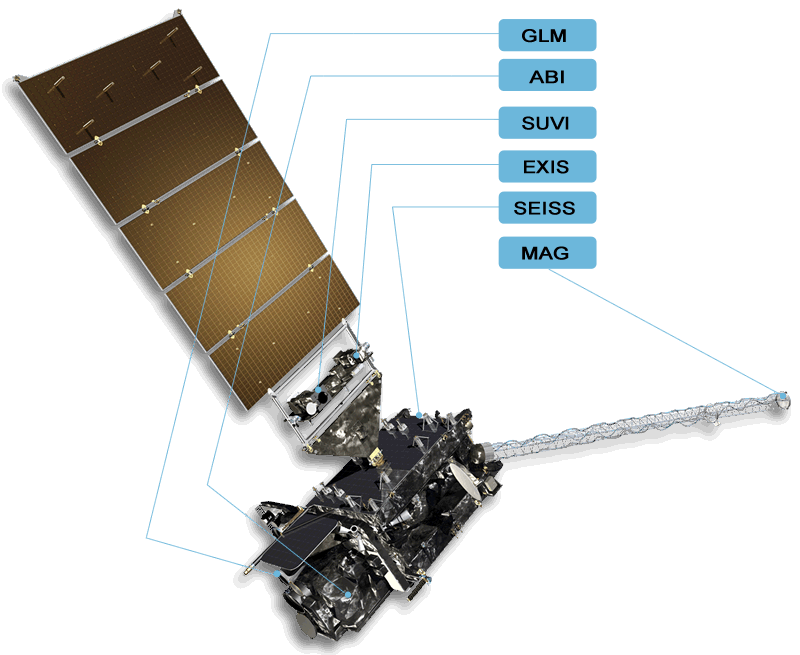
The GOES-R series spacecraft bus is three-axis stabilized and designed for 10 years of on-orbit operation preceded by up to five years of on-orbit storage. The spacecraft carries three classifications of instruments: nadir-pointing, solar-pointing, and in-situ. Visit the Spacecraft page of this site for more information.
Explore the GOES-R Series spacecraft: Use the quick view buttons above to swap the views of the spacecraft, launch the spacecraft 3d model using the button below, watch the video below and use the Spacecraft & Instruments links below.
Spacecraft Specifications
- 6.1 m x 5.6 m x 3.9 m (20.0 ft x 18.4 ft x 12.8 ft)
- 2,857 kg (6,299 lbs) dry mass
- 5,192 kg (11,446 lbs) at launch (fueled)
MORE DETAIL:
Spacecraft & Instruments
GOES-R "Beauty Pass" Video
A fly by in space of GOES-R. Note: there is no audio, therefore no closed captions.
Earth from GOES
Description | More DetailsThe most recent images of Earth's western hemisphere from the GOES constellation.

Environmental satellites provide data in several different formats. The most commonly used channels on weather satellites are the visible, infrared, and water vapor.
Visible satellite images, which look like black and white photographs, are derived from the satellite’s signals. Clouds usually appear white, while land and water surfaces appear in shades of gray or black. The visible channel reflects solar radiation. Clouds, the Earth's atmosphere, and the Earth's surface all absorb and reflect incoming solar radiation. Since visible imagery is produced by reflected sunlight (radiation), it is only available during daylight.
In the infrared (IR) channel, the satellite senses energy as heat. The Earth’s surface absorbs about half of the incoming solar energy. Clouds and the atmosphere absorb a much smaller amount. The Earth’s surface, clouds, and the atmosphere then re-emit part of this absorbed solar energy as heat. The infrared channel senses this re-emitted radiation. Infrared imagery is useful for determining cloud features both at day and night.
Water vapor imagery is used to analyze the presence and movement of water vapor moisture in the upper and middle levels of the atmosphere. The wavelength spectrum used to detect water vapor is in the 6.7 to 7.3 micrometer wavelength range. The darker regions in water vapor imagery are areas where very little water vapor exists in the middle and upper troposphere, and the lighter regions are very moist. Water vapor imagery is a very valuable tool for weather analysis and prediction because water vapor imagery shows moisture in the atmosphere, not just cloud patterns. This allows meteorologists to observe large-scale circulation patterns even when clouds are not present.
The National Oceanic and Atmospheric Administration (NOAA) maintains two primary constellations of environmental satellites: geostationary and polar-orbiting. These satellites are part of NOAA's integrated observing system, which includes satellites, radar, surface automated weather stations, weather balloons, sounders, buoys, instrumented aircraft and other sensors, along with the data management infrastructure needed for this system.
Geostationary satellites orbit 35,800 km (22,300 miles) above Earth's equator at speeds equal to Earth's rotation, which means they maintain their positions and provide continuous coverage. Information from geostationary satellites is used for short-term (1 day) weather forecasting and severe storm warning and tracking.
Polar-orbiting satellites make regular orbits around the Earth’s poles from about 833 km (517 miles) above the Earth’s surface. The Earth constantly rotates counterclockwise underneath the path of the satellite, making for a different view with each orbit. Information from polar-orbiting satellites is used for mid-range (3-7 day) forecasts and advanced warnings of severe weather.
GOES satellites continually view the continental United States, Pacific and Atlantic Oceans, Central and South America, and Southern Canada. To fully cover Alaska, Hawaii, the entire continental United States and the Pacific and Atlantic Oceans (for tropical storms), NOAA operates two GOES satellites simultaneously: GOES East and GOES West. GOES East is located at 75.2° W and provides most of the U.S. weather information. GOES West is located at 137.2°W over the Pacific Ocean. In addition to two operational satellites, NOAA also maintains an on-orbit spare.
Since 1975, GOES have provided continuous imagery and data on atmospheric conditions and solar activity (space weather). They have even aided in search and rescue of people in distress. GOES data products have led to more accurate and timely weather forecasts and better understanding of long-term climate conditions. NASA builds and launches the satellites and NOAA operates them.
GOES-R launched on November 19, 2016, and was followed by GOES-S on March 1, 2018. GOES-T launched on March 1, 2022, and GOES-U launched on June 25, 2024.
More Details

GOES-U, the final satellite in the GOES-R Series, launched on June 25, 2024. GOES-U launch aboard a Falcon Heavy rocket from Launch Complex 39A, at NASA’s Kennedy Space Center in Florida. GOES-U reached geostationary orbit on July 7, 2024, and was renamed GOES-19. GOES-19 entered operations as GOES East on April 7, 2025, replacing GOES-16.
GOES-T, the third satellite in the GOES-R Series, launched on March 1, 2022. GOES-T lifted off from Space Launch Complex 41 at Cape Canaveral Space Force Station, Florida, aboard an Atlas V 541 rocket. GOES-T reached geostationary orbit on March 14, 2022, and was renamed GOES-18. GOES-18 replaced GOES-17 as the operational GOES West satellite at 137.0 degrees west longitude on January 4, 2023.
GOES-S launchedon March 1, 2018 and was renamed GOES-17 when it reached geostationary orbit on March 12, 2018. GOES-17 served as GOES West from February 12, 2019 until it was replaced by GOES-18 on January 4, 2023. GOES-17 now resides in on-orbit storage.
The first satellite in the series, GOES-R, launched on November 19, 2016, and became GOES-16 when it reached geostationary orbit. GOES-16 replaced GOES-13 as NOAA’s operational GOES East satellite at 75.2 degrees west longitude on December 18, 2017. GOES-16 is now the on-orbit standby for the operational constellation after being replaced by GOES-19 in the GOES East position on April 7, 2025.
GOES satellites are placed into a geosynchronous orbit that keeps them over a specific location on the earth. By maintaining a position hovering over a fixed point on Earth's surface, GOES are able to constantly monitor atmospheric conditions in a particular portion of the Earth's atmosphere. Note that non-geosynchronous orbits (for example polar orbits) move over an ever-rotating earth underneath them, therefore seeing a constantly changing view, which has advantages for other types of missions.
More Details
GOES-R Launch Sequence and Deployments
GOES-19
GOES-19 entered operational service as NOAA’s GOES East on April 7, 2025, replacing GOES-16. From its operational location of 75.2 degrees west longitude, GOES-19 is keeping watch over most of North America, as well as South America, the Caribbean, and the Atlantic Ocean to the west coast of Africa.
Learn more about GOES-19’s transition to operations
View GOES-19 (GOES East) imagery at the GOES Image Viewer
GOES-18
GOES-18 replaced GOES-17 as NOAA’s operational GOES West on January 4, 2023. From its operational location of 137.0 degrees west longitude, GOES West is in position to watch over the western contiguous United States, Alaska, Hawaii, Mexico, Central America, and the Pacific Ocean to New Zealand.
Learn more about GOES-18’s transition to operations
View GOES-18 (GOES West) imagery at the GOES Image Viewer
GOES-16
GOES-16 resides at 104.7 degrees west longitude between GOES East and GOES West and serves as the backup for the operational constellation.
Recent News
News Page-
November 25, 2025: 2025 Atlantic Hurricane Season Marked by High-Powered Storms, No U.S. Landfalling Hurricanes

The 2025 Atlantic hurricane season, which officially ends on Nov. 30, showcased near-normal activity, marked by periods of very strong storms. The season fell within the predicted ranges for named storms, hurricanes, and major hurricanes issued by NOAA’s Climate Prediction Center in the August Outlook. The Atlantic basin produced 13 named storms (winds of 39 mph or greater), of which five became hurricanes (winds of 74 mph or greater) and four intensified to major hurricanes with winds reaching 111 mph or greater. No hurricanes made landfall in the continental U.S. for the first time since 2015. NOAA satellites worked together to monitor the Atlantic basin for the development of tropical storm systems and track storms after they formed. GOES-19 data was instrumental for tracking the development, movement, intensity, and lightning activity within tropical storms and hurricanes in near real-time.
-
November 20, 2025: 10 Memorable Images Captured by NOAA’s GOES Satellites

GOES-13 visible imagery of the moon on July 14, 2006 From devastating storms and destructive wildfires to disruptive solar eruptions and captivating atmospheric phenomena, NOAA’s GOES satellites have seen it all. Since 1975, GOES have been our “eyes in the sky,” keeping constant watch over the Western Hemisphere to warn us of severe weather and hazards while providing breathtaking views of Earth. To mark 50 years of GOES in orbit, NOAA is looking back at ten notable events captured by these groundbreaking satellites.
November
-
September 29, 2025: Record-breaking Hurricanes Tracked by NOAA Satellites

GOES satellite-derived winds for Hurricane Patricia, the most intense hurricane on record in the Western Hemisphere, on Oct. 23, 2015 NOAA satellites have witnessed some pretty extreme events, from massive wildfires and explosive volcanic eruptions to a 515-mile-long lightning flash. Along the way, the satellites have also tracked many record-breaking hurricanes, using a variety of instruments and data products to provide a comprehensive picture of these storms. NOAA satellites provide early warning that a storm is forming, monitor and track the movement of storms, and estimate storm intensity. They also aid emergency response to flooding from landfalling tropical systems. From measuring the most intense to the fastest developing hurricanes, NOAA satellites have provided critical information for forecasters to understand and predict these powerful storms and help communities prepare for their impact.
September
-
August 28, 2025: Earth from Orbit: Hurricane Katrina: Twenty Years Later

On Aug. 29, 2025, Hurricane Katrina devastated New Orleans and coastal Mississippi. It was one of the deadliest hurricanes on record and remains the costliest hurricane in U.S. history. The 2005 Atlantic hurricane season was record-breaking, with 27 named storms, 14 hurricanes, and three Category 5 storms. That record remained until 2020, when 30 named storms developed. NOAA satellites tracked Katrina as it developed near the Bahamas, made initial landfall on the southeastern coast of Florida, rapidly intensified into a Category 5 hurricane, and finally left its mark on New Orleans and coastal Mississippi. Today, NOAA satellites are more advanced than ever. NOAA satellite advancements have resulted in more timely and accurate forecasts and warnings, more precise landfall predictions, and a better understanding of hurricane dynamics. While satellites can’t stop hurricanes, they give us knowledge to prepare, protect and save lives. As we remember the impact of Hurricane Katrina, NOAA satellites remain our sentinels in the sky, providing critical data.
-
August 22, 2025: Earth from Orbit: Category 5 Erin is the First Atlantic Hurricane of 2025

After a relatively quiet start to the Atlantic hurricane season, Erin became the first hurricane of the year in the Atlantic basin on Aug. 15 and rapidly intensified into a major Category 5 storm the following day. This intensification is one of the fastest on record. NOAA satellites provided vital information for forecasting and monitoring Erin. Rapid, high-resolution imagery from GOES-19 gave forecasters a detailed look at Erin’s structure, including its pinhole eye. Rapidly updating imagery also helps forecasters better monitor cloud features and more confidently estimate the center of a tropical storm or hurricane. GOES-19 infrared imagery helped forecasters to track the location and persistence of rain bands near the Caribbean islands, aiding predictions of rainfall and potential flash flooding. GOES-19 also monitored lightning activity within Hurricane Erin as it rapidly intensified.
August
-
June 26, 2025: Lightning Safety Awareness Week: Detecting Lightning From Space

Lightning is a dangerous hazard that poses a significant threat to life and property. For National Lightning Safety Awareness Week (June 22-28, 2025), NOAA is highlighting the capabilities of its Geostationary Lightning Mapper (GLM) instrument onboard the GOES-18 (GOES West) and GOES-19 (GOES East) satellites. GLM detects and maps lightning activity within storms. Its data can show forecasters areas where the risk of lightning strikes presents a public safety hazard. GOES data can also help predict the occurrence of lightning in the future. An AI model called LightningCast predicts where lightning is most likely to occur up to 60 minutes in advance. Forecasters use LightningCast to help keep people who are working and participating in outdoor events safe.
-
June 25, 2025: NOAA’s GOES-U Satellite: One Year Later

CCOR-1 imagery of a CME that triggered a severe geomagnetic storm warning for Earth on May 31, 2025. CCOR-1 observed the CME 21 minutes before other coronagraph imagery was available. On June 25, 2024, GOES-U, the final satellite in NOAA’s GOES-R Series, launched from NASA’s Kennedy Space Center in Florida. Once GOES-U reached geostationary orbit on July 7, the satellite was renamed GOES-19. As NOAA marks the first anniversary of sending GOES-U into space, we check in with the newest satellite in NOAA’s fleet. On April 7, 2025, GOES-19 replaced GOES-16 as NOAA’s operational GOES East satellite. In its new role, GOES-19 serves as NOAA's primary geostationary satellite for monitoring much of the Western Hemisphere. The satellite tracks hurricanes and tropical storms in the Atlantic Ocean basin and monitors severe weather, atmospheric rivers, wildfires, volcanic eruptions and other environmental events affecting the contiguous U.S. GOES-19 has already proved vital for short-term forecasts and warnings of severe weather as well as detecting and monitoring hazards such as wildfires and smoke. The satellite’s new CCOR-1 instrument is helping NOAA’s Space Weather Predication Center sharpen its geomagnetic storm forecasts and provide earlier warnings, buying critical time for the operators of power grids, satellites, aviation systems, and communication networks.
-
June 5, 2025: Earth From Orbit: NOAA Satellites Monitor Canadian Wildfires and Smoke

NOAA satellites have been closely monitoring heat signatures and thick plumes of smoke (some stretching thousands of miles) from wildfires burning across Canada. Numerous fires flared up last week causing widespread evacuations in three provinces. Manitoba alone had about 17,000 residents evacuated. Smoke from these wildfires has been wafting southward, affecting air quality across much of the northern, central, and eastern U.S. GOES East and GOES West tracked the smoke as it spread across North America in near real-time. GOES West also detected the formation of pyrocumulonimbus clouds over fires burning in Alberta, Canada. These thunderstorms can form above wildfires due to intense heat and rising smoke.
June
-
May 27, 2025: 50 Years of Monitoring the Stormy Seas: Hurricane Tracking with NOAA’s GOES Satellites

Image of Three hurricanes in the Atlantic on Sept. 18, 2017: Irma, Jose and Katia. For 50 years, NOAA’s Geostationary Operational Environmental Satellites (GOES) have kept a constant vigil over the Western Hemisphere. These sentinels in the sky provide essential information to forecasters, first responders, emergency managers, local officials and the public about severe weather and hazards. Each new generation of GOES has advanced our understanding of hurricanes and led to significant forecast and warning improvements, protecting lives and property through increasingly accurate, timely and reliable data. As hurricane season begins, NOAA looks back at how far hurricane observations from geostationary orbit have come since 1975.
-
May 23, 2025: NOAA Satellites Track Deadly Severe Weather Across the Nation

Image of Hurricane Milton from NOAA's GOES-16 satellite on Oct. 8, 2024. NOAA satellites monitored potent and complex spring weather pattern responsible for nearly a week-long stretch of severe weather, including two destructive tornado outbreaks across the central U.S. from May 15-16 and May 18-20, 2025. The National Weather Service used NOAA satellite data for advanced warnings, real-time updates, and on-site support to emergency managers during the storm. In some parts of Kentucky, tornado warnings had lead times of up to 40 minutes. GOES-19 tracked the system in near real-time as it raced across the U.S. GOES-19 imagery revealed where the storms were most intense and allowed forecasters to monitor rapidly changing conditions. The satellite’s lightning mapper detected rapid increases in lightning activity, indicating intensifying storms. Forecasters also use GOES data in new AI models that predict the likelihood that a developing thunderstorm will produce severe weather or hazardous lightning an hour or more in advance.
-
May 22, 2025: NOAA Satellites Have You Covered This Hurricane Season

Image of Hurricane Milton from NOAA's GOES-16 satellite on Oct. 8, 2024. The 2025 Atlantic Hurricane Season officially begins June 1, and NOAA’s eyes in the sky are ready for whatever the season may bring. NOAA satellites are critical for monitoring the development, intensification and track of tropical storms and hurricanes each hurricane season. Imagery from these satellites help forecasters at the National Hurricane Center determine when a tropical depression or storm has formed and when the structure of the system may allow for rapid intensification. These data are crucial for warning the public of storm surge, wind and rainfall hazards associated with landfalling tropical storms and hurricanes.
-
May 20, 2025: NOAA unveils powerful convergence of AI and science with revolutionary Next-Generation Fire System technology

GOES-18 imagery of California's Park Fire and smoke on July 26, 2024 Less than a year after being evaluated in NOAA’s Fire Weather Testbed, the automated satellite fire detection capability of the experimental Next Generation Fire System (NGFS) has been embraced by the firefighting community and is being increasingly integrated into operations across the country. The first of two key features of the revolutionary system are the Advanced Baseline Imager, the primary instrument on NOAA’s two GOES geostationary satellites orbiting 22,000 miles above the equator. The second is a set of NGFS algorithms that continuously comb through enormous volumes of data generated by the imager and automatically identifies heat anomalies or hot spots, even through clouds and smoke.
-
May 20, 2025: Environmental Intelligence: Sensing Danger from Orbit

GOES-16 image of Hurricane Helene on September 26, 2024 NOAA satellites provide data that Americans use daily. Maintaining this “environmental intelligence” is critical to U.S. Armed Forces operations. NOAA satellite data – whether used for monitoring erosion around deep-water ports, forecasting wind and air quality near airstrips, or sustaining reliable global positioning accuracy – is vital for defending national security. NOAA’s information feeds weather prediction models used every day in the United States and around the world. Interagency collaborations are a force multiplier for observations of both Earth and space, as shown through agreements between NOAA, NASA, the Department of Defense, and other federal partners. Frameworks like these improve forecasts by sharing data and technology with operators.
-
May 7, 2025: Satellites and Fire: AMS SatMOC Short Courses

The American Meteorological Society (AMS) Committee on Satellite Meteorology, Oceanography, and Climatology (SatMOC) will offer a virtual short course with NOAA collaborators titled “Satellites and Fire" during June 2025. This short course will consist of four virtual training sessions of four hours each. The training sessions are scheduled for 9:00 AM to 1:00 PM ET on June 17, 18, 24, and 25, 2025. This series of four training sessions will demonstrate the use of environmental satellite data to monitor the stages of wildland fires and the vegetative conditions associated with those stages. All sessions will include hands-on exercises for selecting and applying environmental satellite data products used to monitor wildland fire conditions.
May
-
May 2, 2025: Earth from Orbit: NOAA Satellites Track Large New Jersey Wildfire

NOAA satellites monitored a large fire that erupted in Ocean County, New Jersey, on April 22, 2025, and quickly grew into one of the worst fires in the state’s history. GOES-19 monitored the movement and intensity of the fire in near real-time as it rapidly spread. NOAA also used GOES-19 imagery in its new wildfire tool, the Next Generation Fire System (NGFS). NGFS uses artificial intelligence to scan satellite imagery and quickly identify new fires down to the neighborhood level. In an era of increasingly severe wildfires, NOAA satellites provide indispensable tools for protecting communities and managing natural disasters.
May
-
April 22, 2025: Earth From Orbit: Happy Earth Day from NOAA Satellites
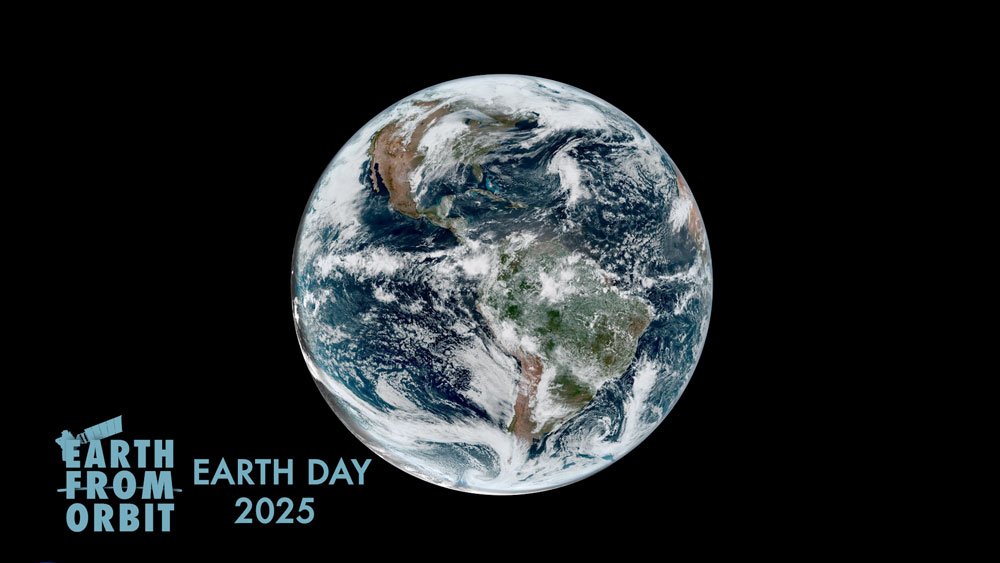
NOAA satellites have been monitoring Earth’s weather and environment since 1970, which also happened to be the year the first official Earth Day took place! Building upon early pioneering efforts by NASA and others, today’s advanced satellites provide critical information that feeds forecast models and warns us of severe weather and environmental hazards. For NOAA, every day is Earth Day. Take a look back at our world since last April 22.
-
April 7, 2025: NOAA’s GOES-19 satellite now operational, providing critical new data to forecasters
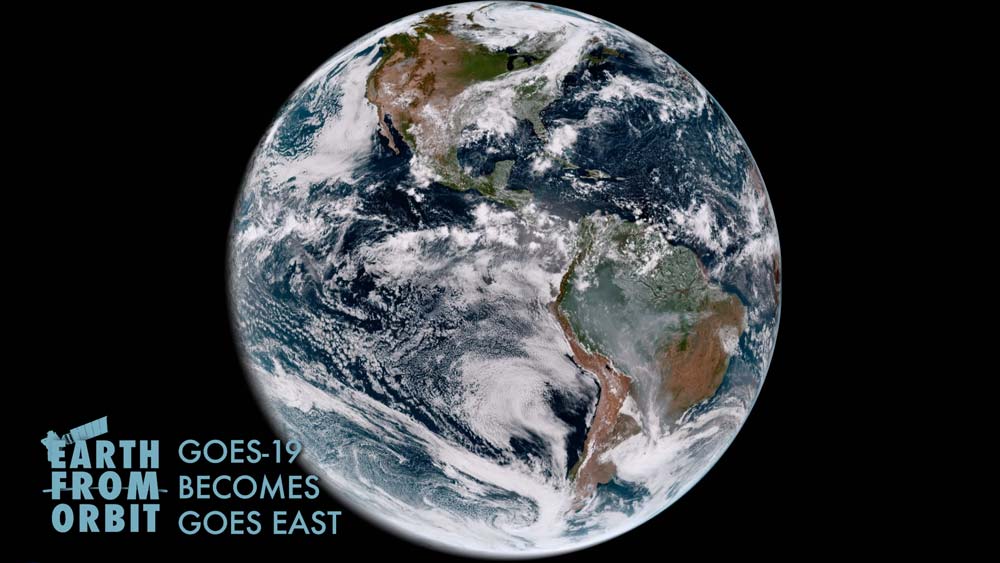
On April 7, 2025, GOES-19 entered operational service as GOES East. The fourth and final satellite in the GOES-R Series launched on June 25, 2024. In its new role, GOES-19 watches over much of the Western Hemisphere. It will track hurricanes and tropical storms in the Atlantic basin, as well as monitor severe weather, atmospheric rivers, wildfires, volcanic eruptions and other environmental events. The satellite also carries a suite of space weather instruments, including NOAA’s first compact coronagraph instrument (CCOR-1). CCOR-1 images the outer layer of the sun’s atmosphere to detect and characterize coronal mass ejections and warn of impending geomagnetic storms. With GOES-19 joining the fleet, NOAA’s geostationary satellite constellation is set to carry on its longstanding mission and deliver life-saving data into the 2030s. Watch the Earth from Orbit video.
April
-
March 12, 2025: How NOAA Satellites Help Us Stay Ahead of Severe Weather Season
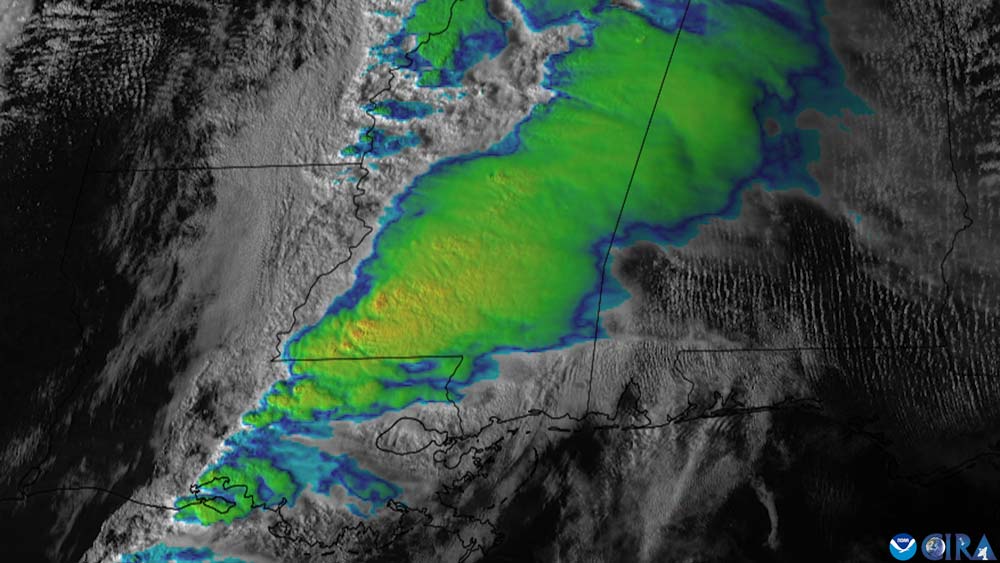
GOES-16 visible and infrared imagery of a squall line of severe thunderstorms producing damaging winds marching through the Southeast U.S. on March 4, 2025. Each year, the arrival of spring brings the increasing probability for severe weather to the United States. From their orbits, NOAA satellites play a vital role in detecting and tracking severe weather by providing forecasters with critical data to predict and monitor life-threatening conditions. Geostationary Operational Environmental Satellites (GOES) enable continuous coverage of severe weather threats in the U.S., while the polar-orbiting Joint Polar Satellite System (JPSS) satellites deliver higher resolution global observations for long-term forecasting. Together, these advanced satellites help safeguard lives and property.
-
March 7, 2025: Earth from Orbit: NOAA Satellites Monitor Hazardous Early Spring Storm
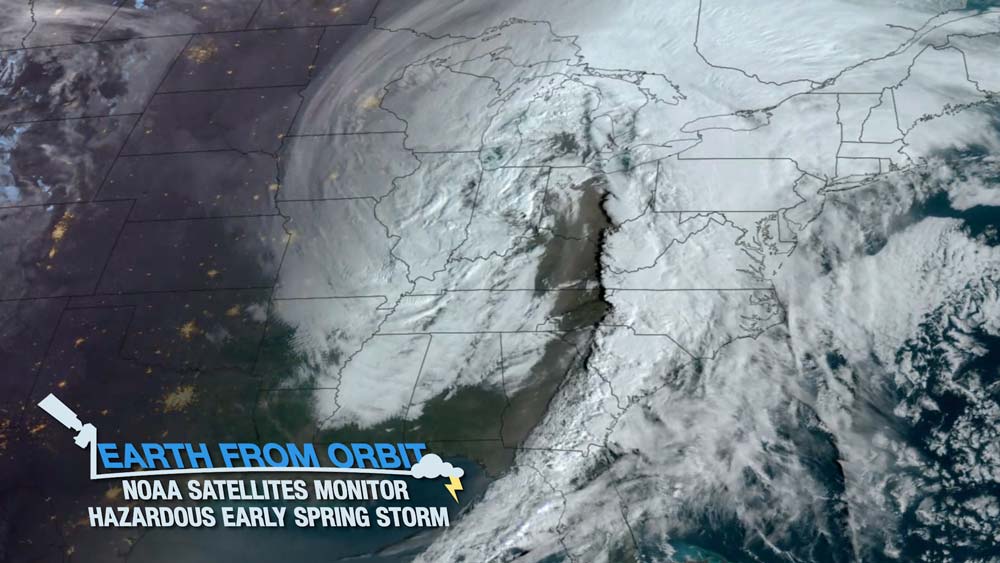
NOAA satellites monitored a large storm system as it pushed across the Central U.S. in early March 2025. The system prompted widespread weather alerts for everything from blizzard warnings and wind advisories to tornado watches and heightened wildfire risks across much of the country. NOAA’s GOES satellites tracked the system in near real-time, providing forecasters and first responders with critical information about the storm. The Advanced Baseline Imager (ABI) helped track rapidly changing weather conditions, analyze the structure of the storm, and pinpoint areas where the storm was the most intense. The ABI also identified several wildfire ignitions across the Southern Plains, alerting the National Weather Service to the threat. The Geostationary Lightning Mapper (GLM) measured lightning activity and helped provide early warning that the storm was intensifying. Dynamic storm systems like this demonstrate the strength and unpredictability of spring weather. NOAA satellites remain vital for forecasting and monitoring these storms as well as their impacts, helping to protect lives, property, and economic vitality.
March
-
February 14, 2025: What is El Niño?
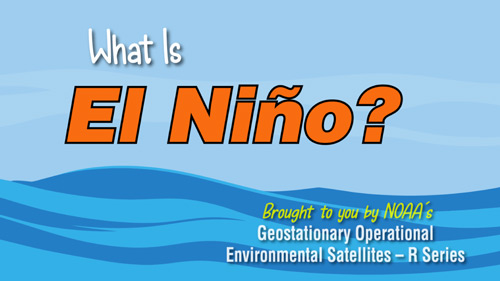
Have you ever heard a news headline mentioning that unusual or extreme weather is expected due to El Niño? But what exactly is El Niño? And what does it have to do with our weather? A new video from NOAA SciJinks explains this phenomenon and how meteorologists can use information from GOES-R satellites to help predict if an El Niño pattern is forming.
-
February 6, 2025: Earth from Orbit: NOAA Satellites Track Powerful Atmospheric Rivers Impacting the West Coast
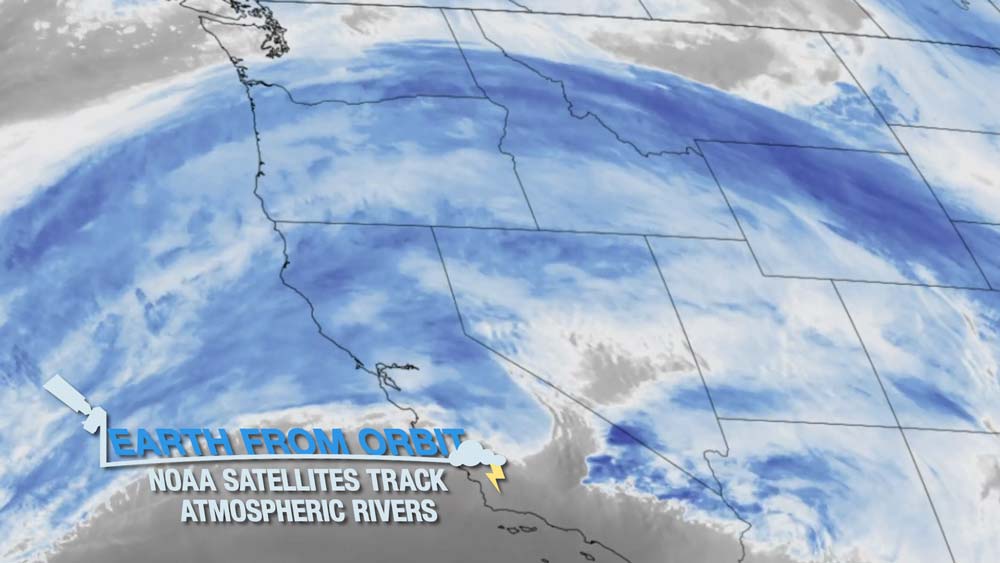
Since Jan. 31, 2025, NOAA satellites have been closely monitoring a series of strong atmospheric rivers bringing heavy rain and mountain snow from central California to the Pacific Northwest, the Sierras, southern Cascades, and northern Rocky mountains. GOES-18 (GOES West) provides detailed information about moisture in the atmosphere and allows forecasters to track atmospheric rivers as they happen. The satellite provides critical data about the movement of clouds and water vapor patterns that help to forecast heavy rain and flash flooding from atmospheric rivers. As atmospheric rivers continue to impact the western U.S., NOAA satellites will closely monitor these events and provide critical information to forecasters and local communities.
February
-
January 21, 2025: GOES-R/GeoXO Newsletter, October – December 2024
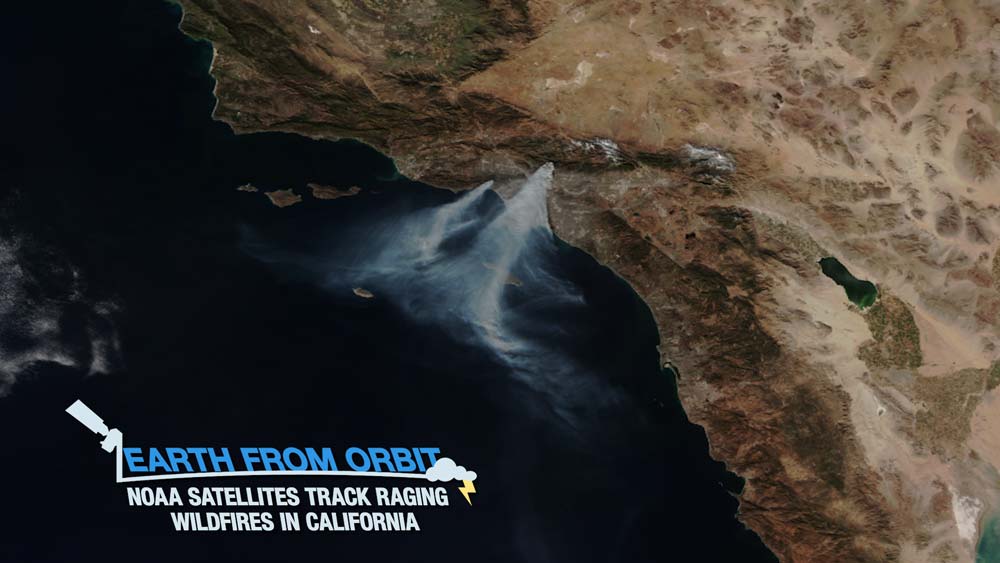
The GEO team gathered in October 2024 to celebrate building and launching all four satellites in the GOES-R Series. The GOES-R/GeoXO quarterly newsletter for October – December 2024 is now available. As GOES-19 prepares to enter operational service, the team is recognized for the tremendous amount of hard work and dedication they have put into GOES-R since 1999. From the very start of the program, the GOES-R team has been recognized as setting the standard for satellite and ground system development as well as inter-agency collaboration. The GOES-R system will continue to serve our nation providing observations of severe weather and environmental conditions into the 2030s, while the focus of our team now turns to GeoXO development. We completed the Mission Definition Review in December, are working on evolving the ground system for GeoXO, and are preparing to enter the preliminary design phase. Congressional support of GeoXO has us on track for planned launches. It is an exciting time as we make NOAA’s next-generation geostationary satellite system a reality, bringing new and improved capabilities to meet our users’ needs and address emerging environmental challenges.
-
January 21, 2025: Earth from Orbit: NOAA Satellites Track Raging Wildfires in California

NOAA satellites are closely monitoring wildfires burning in the Los Angeles metropolitan area. The first blazes erupted on Jan. 7, 2025, and quickly exploded in size and intensity, prompting widespread evacuation orders. The destructive wildfires have destroyed thousands of structures and claimed the lives of at least 25 people according to reporting by local authorities. GOES-18 (GOES West) monitored the fires in near real-time, measured the intensity, tracked the spread and movement of smoke.
-
January 14, 2025: NOAA Celebrates 50 Years of GOES Satellites
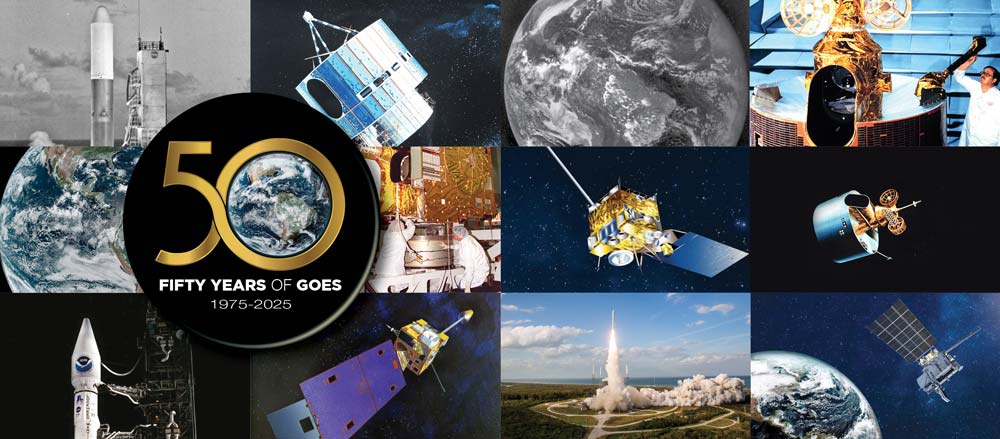
In 2025, NOAA is celebrating 50 years of its heralded Geostationary Operational Environmental Satellite program, known as GOES. For five decades, NOAA and NASA have partnered to advance NOAA satellite observations from geostationary orbit. GOES are our sentinels in the sky: keeping constant watch for severe weather and environmental hazards on Earth and dangerous space weather. As NOAA celebrates the long legacy of the GOES, we continue to rely on these satellites for short-term forecasts of hazardous weather, detection and monitoring of environmental phenomena like wildfires, smoke, volcanic ash, dust storms and fog, and warnings of approaching space weather that can disrupt communication and navigation systems, disrupt power grids, damage satellites in space and expose astronauts to harmful radiation.
January
-
December 21, 2024: The Winter Solstice Through NOAA’s Newest Eyes in Space

NOAA’s newest satellite, GOES-19, provided a beautiful view of Earth during the winter solstice. Currently positioned over the Western Hemisphere at 89.5° west longitude, between NOAA’s GOES East and GOES West satellites, GOES-19 captured this celestial moment from space while undergoing post-launch testing. Launched on June 25, it is set to replace GOES-16 in the GOES East position this spring. The winter solstice marks a special moment as the shortest day and longest night of the year in the Northern Hemisphere. At precisely 4:21 a.m. EST, the Northern Hemisphere reached its maximum tilt away from the sun, positioning the sun directly over the Tropic of Capricorn, 23.5° south of the equator.
December
-
November 25, 2024: Earth from Orbit: 2024 Atlantic Hurricane Season Wraps UpTEST!!
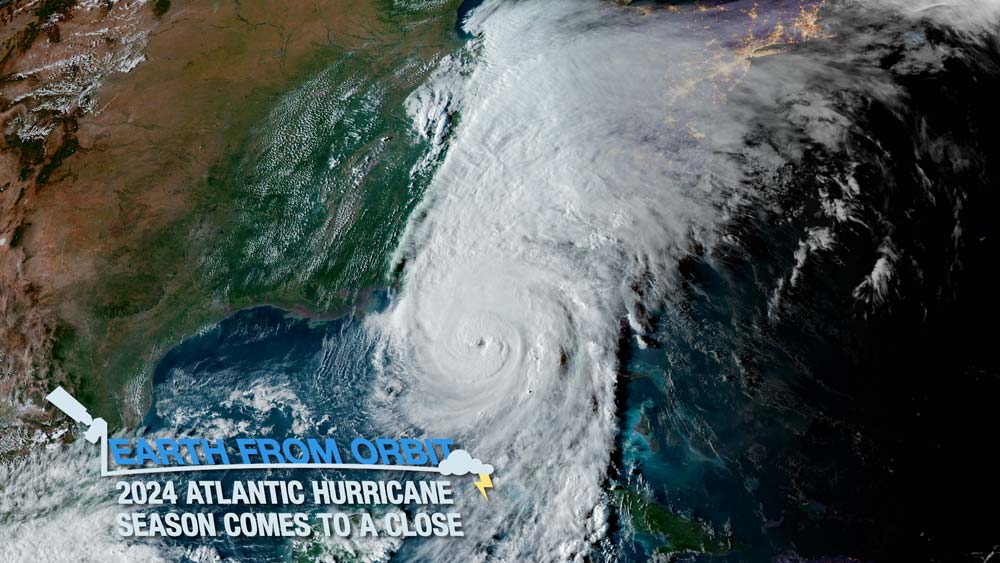
As the 2024 Atlantic hurricane season comes to a close on Nov. 30, NOAA looks back at its above-average activity, with a record-breaking ramp up following a peak-season lull. The Atlantic basin saw 18 named storms with 11 intensifying into hurricanes. Five of those were major hurricanes intensifying into Category 3 or higher. GOES-16 (GOES East) is constantly monitoring the Atlantic basin for the development of tropical storm systems. Once a storm forms, GOES-16 tracks its development, movement and intensity and measures lighting activity in near real-time.
-
November 12, 2024: GOES-19 Captures Extended Images of the Sun's Atmosphere:
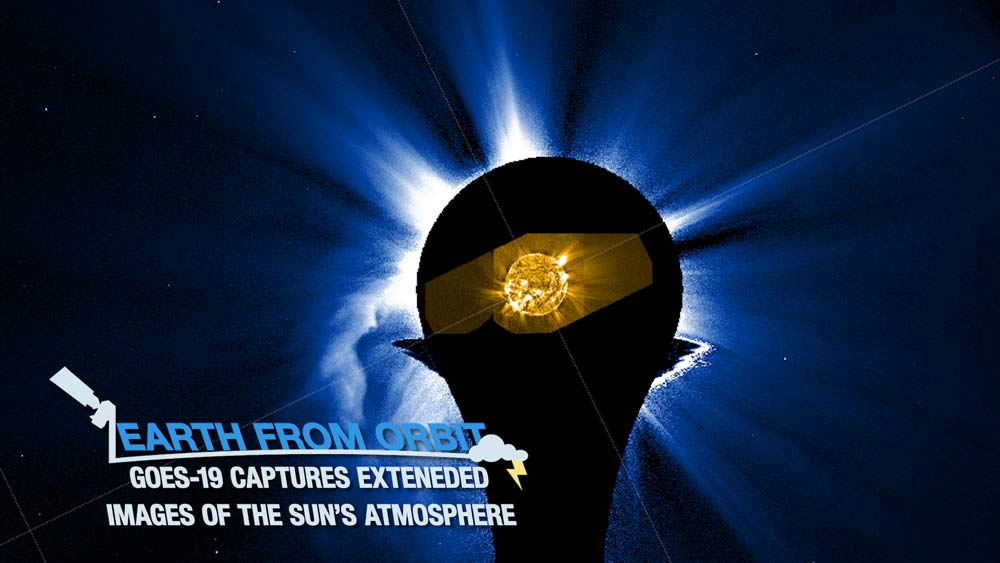
NOAA’s newest satellite, GOES-19, has been monitoring an increasingly active sun, as we enter solar maximum of Solar Cycle 25. The GOES-19 Solar Ultraviolet Imager (SUVI) and a brand-new Compact Coronagraph (CCOR-1) are now observing the sun and its influence on Earth. Recently, the GOES-19 SUVI operated in a special mode, called “extended coronal imaging (ECI).” Typically, SUVI capture’s the sun’s activity in six types of extreme ultraviolet light, each showing different temperatures on the sun. During ECI, SUVI captured images slightly off-center from the sun, using two of these light types (171 Å and 195 Å). By doing this, scientists can create three-panel mosaic images that reveal more of the sun’s outer atmosphere, known as the middle corona. This extended view helps connect the details in SUVI images with the new CCOR-1 images. As GOES-19 undergoes post-launch testing before becoming NOAA’s operational GOES East satellite in spring 2025, its data should be considered preliminary and non-operational. Once operational, the Space Weather Prediction Center (SWPC) will use data from both CCOR-1 and SUVI to issue early warnings and improve the accuracy of forecasts, protecting vital infrastructure from space weather threats.
November
-
October 29, 2024: NOAA Shares First Imagery from GOES-19 SUVI Instrument
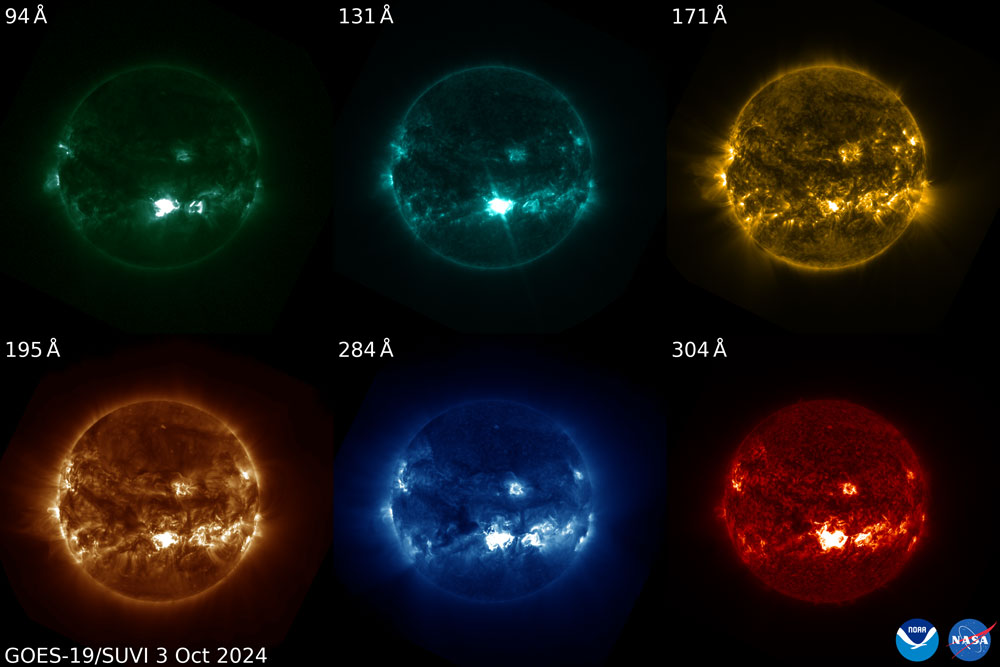
GOES-19 imagery of the Oct. 3, 2024, solar flare shown in six extreme ultraviolet channels. The clearest depiction of the flare is in the 131 Å channel (top center). On Oct. 29, 2024, NOAA shared the first imagery from the GOES-19 Solar Ultraviolet Imager (SUVI). The GOES-19 SUVI, which launched on June 25, 2024, began observing the sun on Sept. 24, 2024. On Oct. 3, 2024, the GOES-19 SUVI captured an X9 solar flare, the most powerful flare so far in the current solar cycle. The sun’s 11-year activity cycle has entered the solar maximum period, meaning phenomena such as solar flares and coronal mass ejections are occurring more frequently than during other parts of the solar cycle. SUVI monitors the sun in the extreme ultraviolet portion of the electromagnetic spectrum to watch for hazardous space weather that could affect Earth.
-
October 17, 2024: NOAA Releases Initial Imagery from the GOES-19 Lightning Mapper
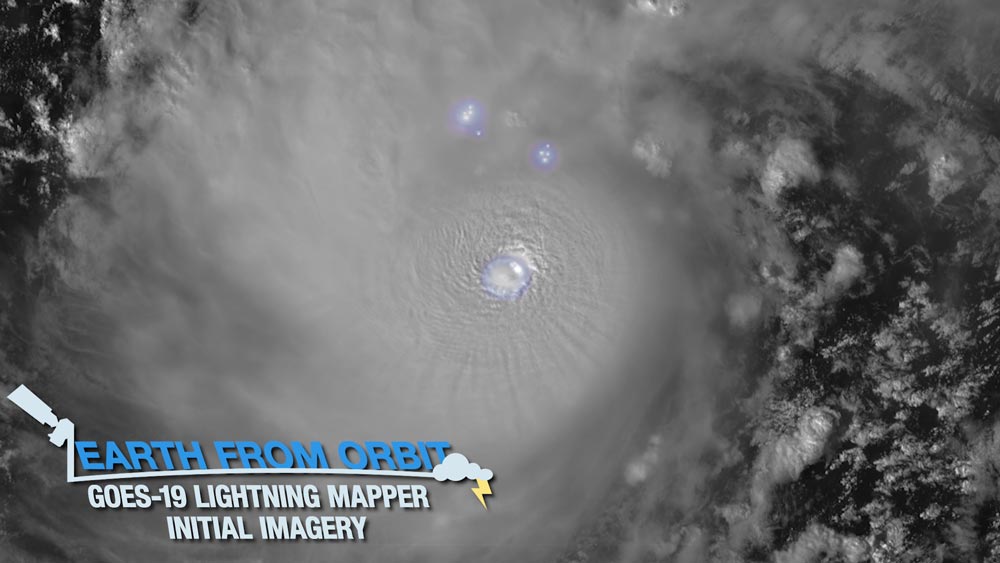
NOAA Releases Initial Imagery from the GOES-19 Lightning Mapper On Oct. 17, 2024, NOAA shared initial imagery from the GOES-19 lightning Mapper. The GOES-19 Geostationary Lightning Mapper (GLM) instrument, launched on June 25, 2024, is now continuously observing lightning over the Western Hemisphere. Recently, the GOES-19 GLM detected and monitored lightning activity in two extremely hazardous hurricanes – Helene and Milton. Lightning activity in the outer rainbands and eyewalls of these hurricanes was associated with rapid intensification. Frequent lightning outside the Hurricane Milton’s core was associated with intense rain bands that produced widespread flash flooding and tornadoes across Florida on Oct. 9, 2024. GOES-19 is currently undergoing post-launch testing, which includes validation and calibration of its instruments, systems and data to prepare it for operations. NOAA plans for GOES-19 to replace GOES-16 as GOES East in April 2025
-
October 3, 2024: GOES-R/GeoXO Newsletter, April – September 2024
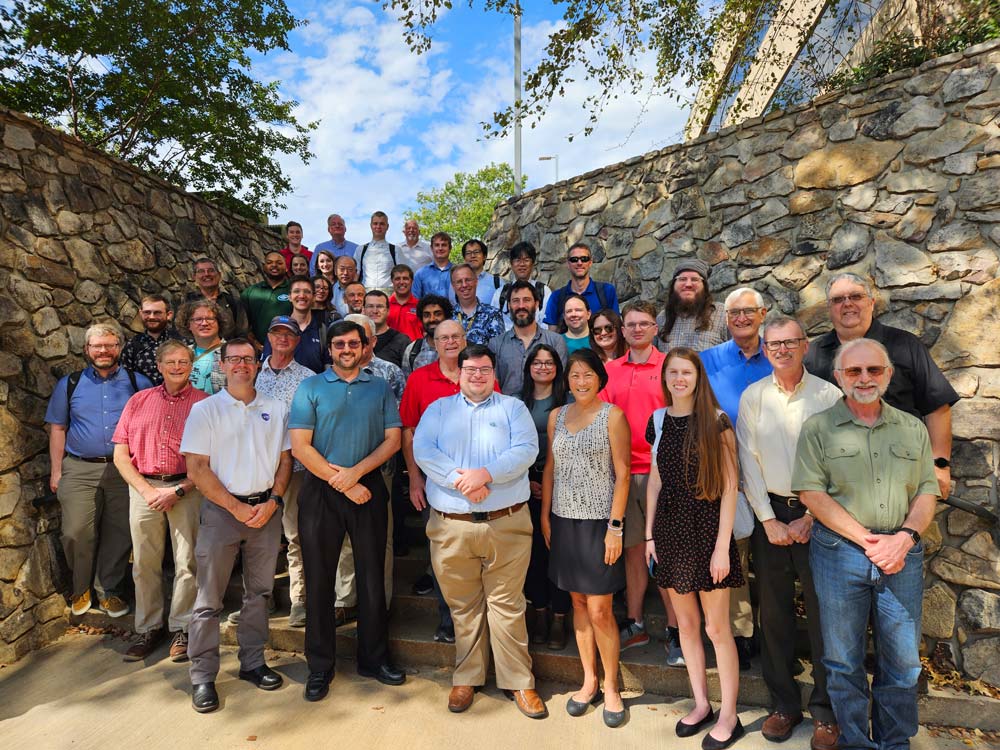
2024 Lightning Science Meeting attendees The GOES-R/GeoXO quarterly newsletter for April – September 2024 is now available. We successfully launched the final satellite in the GOES-R Series! Congratulations to the team for achieving this milestone! After reaching geostationary orbit on July 7, GOES-U was renamed GOES-19. Post-launch testing is underway, and I look forward to GOES-19 becoming GOES East next April. GOES-19 hosts a new space weather instrument, CCOR-1, on behalf of NOAA’s Space Weather Follow-On Program, which will observe the solar corona and provide critical data for space weather forecasting. There has also been a lot of progress on GeoXO. We selected vendors to build the spacecraft and the ACX, OCX and LMX instruments and are on track to complete the Mission Definition Review in late 2024.
October
-
September 24, 2024: NOAA Shares First Data from GOES-19 EXIS Instrument
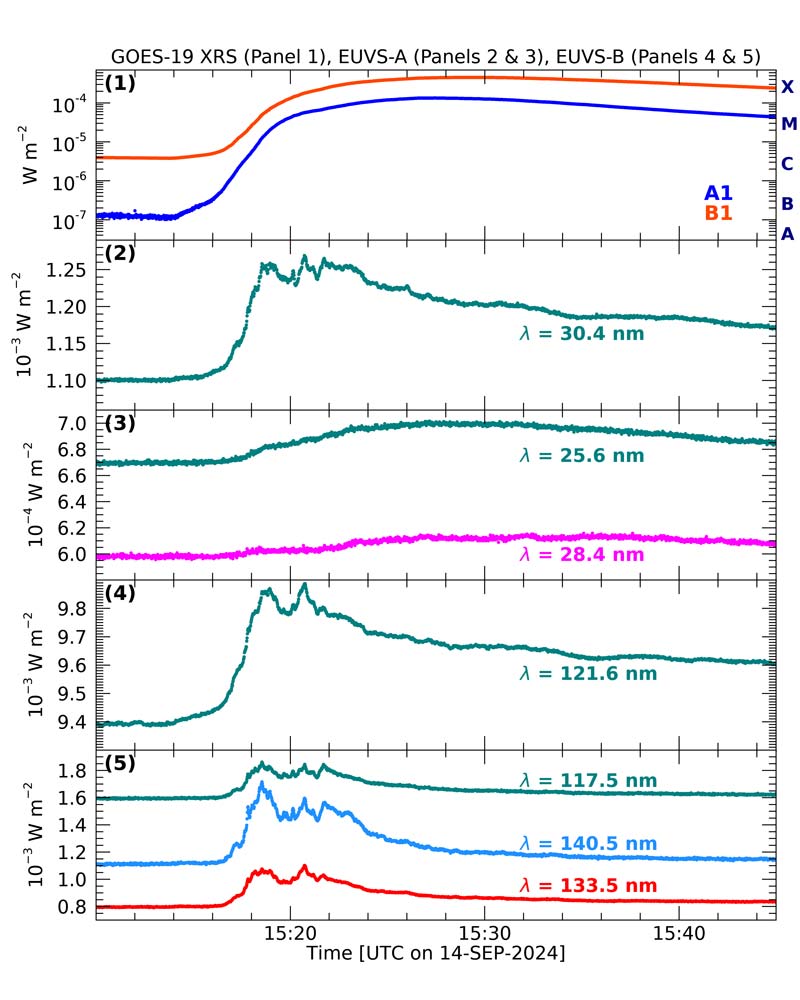
First data from the GOES-19 EXIS. Image credit: NOAA/NASA The Extreme Ultraviolet and X-ray Irradiance Sensors (EXIS) onboard NOAA’s GOES-19 satellite are powered on, performing well and observing the sun. On Sept. 14 2024, EXIS observed an X-class “extreme” solar flare that erupted from an active region of the sun that had just rotated into Earth’s view. Solar flares are huge eruptions of energy on the sun and often produce clouds of plasma traveling more than a million miles per hour. When these plasma clouds reach Earth, they can cause radio communications blackouts, disruptions to electric power grids, errors in GPS navigation, and hazards to satellites and astronauts. This particular flare resulted in aurorae visible as far south as Texas. EXIS, with its multiple sensors, can observe and quantify the light from solar flares and help determine in real-time whether a flare will affect us on Earth. EXIS data will provide NOAA’s Space Weather Prediction Center with early indications of impending space weather storms so forecasters can issue alerts, watches and warnings.
-
September 18, 2024: NOAA Debuts First Imagery from GOES-19
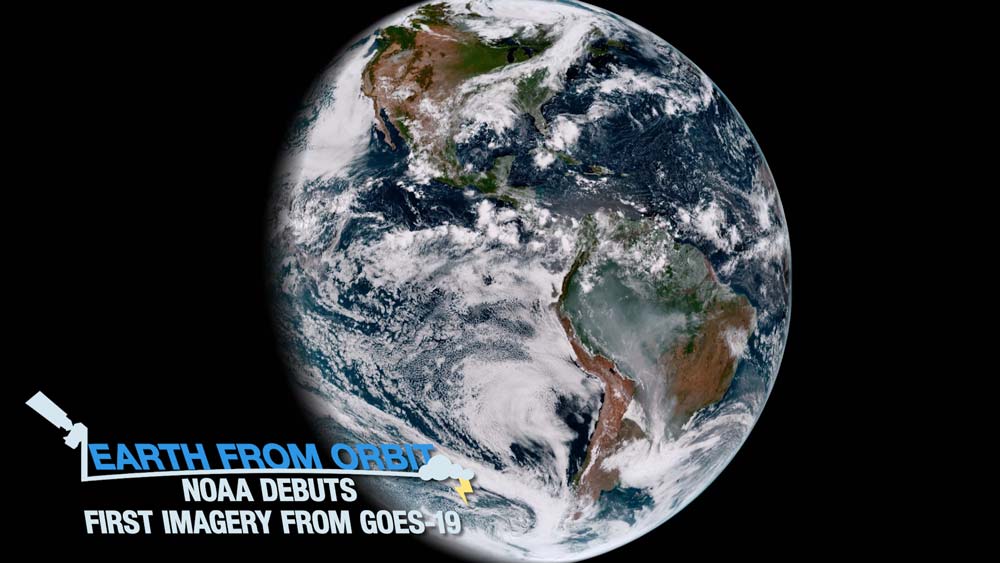
On Sept. 18, 2024, NOAA shared the first images of the Western Hemisphere from its GOES-19 satellite. The satellite’s Advanced Baseline Imager (ABI) instrument recently observed a number of weather events, environmental phenomena, and striking views of Earth. Wildfires in the Midwest and the Amazon blanketed nearby areas with smoke. Storms flared up over the Southeast and a low-pressure system over Canada brought severe weather. Tropical Storm Francine formed in the Gulf of Mexico and quickly developed into a hurricane, making landfall in Louisiana. GOES-19 also captured mesmerizing von Kármán vortices around Guadalupe island, cloud streets over Virginia, and cumulus clouds over the Midwest. GOES-19 is currently undergoing post-launch testing, which includes validation and calibration of its instruments, systems and data to prepare it for operations. NOAA plans for GOES-19 to replace GOES-16 as GOES-East in April 2025.
-
September 13, 2024: Earth from Orbit: Hurricane Francine Slams Northern Gulf Coast
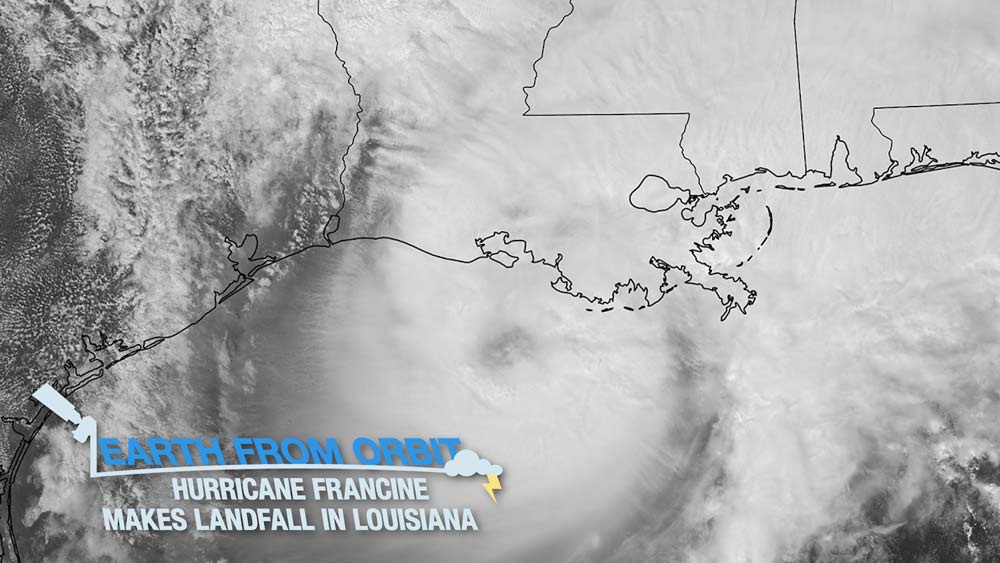
On Sept. 11, 2024, NOAA satellites monitored Hurricane Francine as it made landfall in Louisiana as a Category 2 hurricane. Francine developed into a tropical storm in the Gulf of Mexico on Sept. 9, as the historical peak of Atlantic hurricane season approached. The storm brought flash flooding and caused widespread power outages in Louisiana, Mississippi and Alabama. GOES-16 (GOES-East) watched in near real-time as Francine developed into a tropical storm and intensified into a hurricane. The satellite provided a detailed look of the storm and monitored cloud top cooling and lightning activity within the hurricane.
-
September 4, 2024: NOAA Shares First Data from GOES-19 SEISS Instrument

The Space Environment In-Situ Suite (SEISS) instrument onboard NOAA's GOES-19 satellite on June 25, 2024, is now sending radiation data back to Earth. Data collected from SEISS over the three-day time period from August 23–25, 2024, show a number of radiation belt disturbances. The radiation belts are regions of space around Earth filled with energetic electrons and protons that can damage or interfere with satellite electronics. The GOES-19 SEISS Magnetospheric Particle Sensor - High Energy observed several large dropouts followed by rapid increases in the radiation belt electron and proton fluxes during these disturbances. Following the rapid increases, MPS-HI observed periodic "drift echoes" (short duration flux enhancements), most clearly in the three lowest-energy proton channels (96 keV, 138 keV, and 193 keV traces), as these enhanced fluxes repeatedly drifted around the Earth and passed by the GOES-19 satellite. Once GOES-19 assumes its operational role as NOAA’s GOES-East satellite, the Space Weather Prediction Center will use GOES-19’s SEISS data to issue solar radiation storm and radiation belt alerts.
September
-
August 22, 2024: Earth from Orbit: Hurricane Ernesto
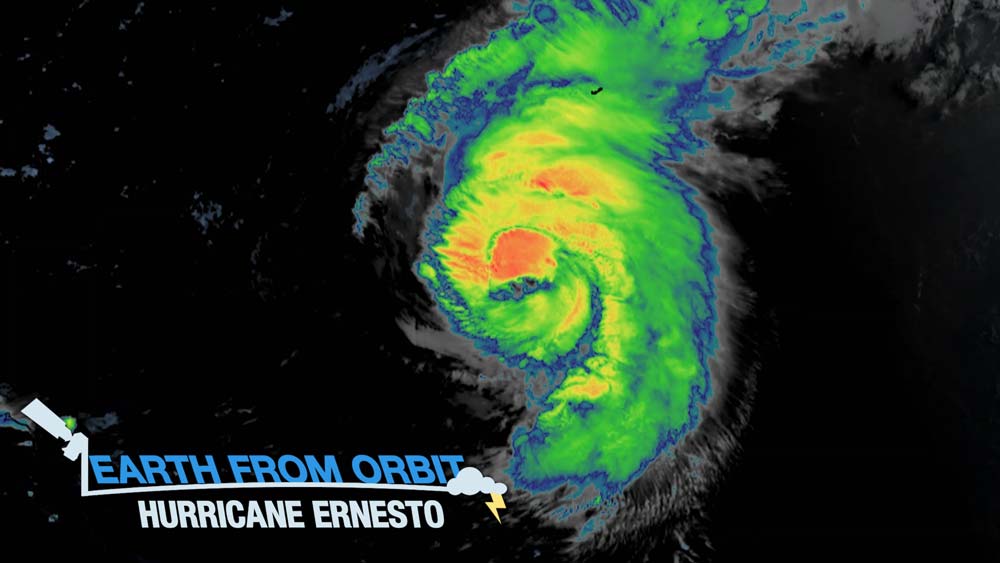
On Aug. 14, 2024, NOAA satellites watched Tropical Storm Ernesto intensify into a hurricane. The storm brought strong winds and flooding to the Virgin Islands and Puerto Rico before moving northward. As it traveled northward over the Atlantic Ocean toward Bermuda, Ernesto intensified into a Category 2 hurricane. On Aug. 17, Hurricane Ernesto made landfall in Bermuda as a Category 1 hurricane. Hurricane Ernesto also caused dangerous swells and rip currents along the U.S. East Coast. GOES-16 monitored the storm as it developed and intensified in near real-time, helping forecasters determine what areas would be impacted. Infrared imagery from GOES-16 indicated what areas of the hurricane were the most intense. The GOES-16 Geostationary Lightning Mapper also captured lightning activity within the storm.
-
August 15, 2024 : Earth From Orbit: A Look Back at Hurricane Debby
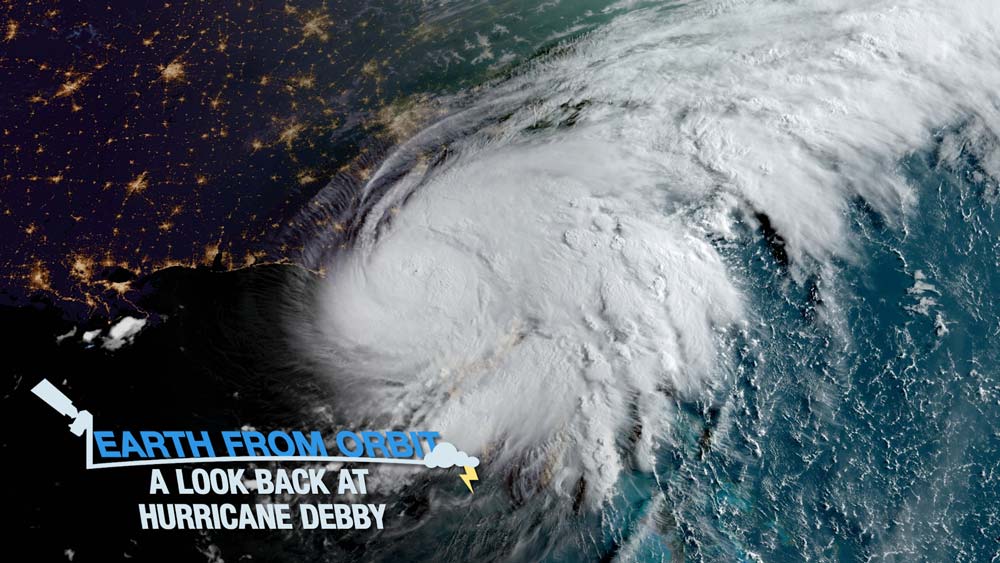
In early August 2024, NOAA satellites tracked Debby, a storm that impacted Florida’s Big Bend region near Steinhatchee before moving up the East Coast, causing widespread flooding and damaging winds as far north as New York state with numerous destructive tornadoes along its path. NOAA’s GOES-16 satellite monitored and tracked the storm in near real-time as it developed and moved northward. GOES-16 imagery revealed details such as cloud top cooling, winds and lightning activity, which help estimate a storm’s intensity.
-
August 13, 2024 : NOAA Shares First Data From GOES-19 Magnetometer
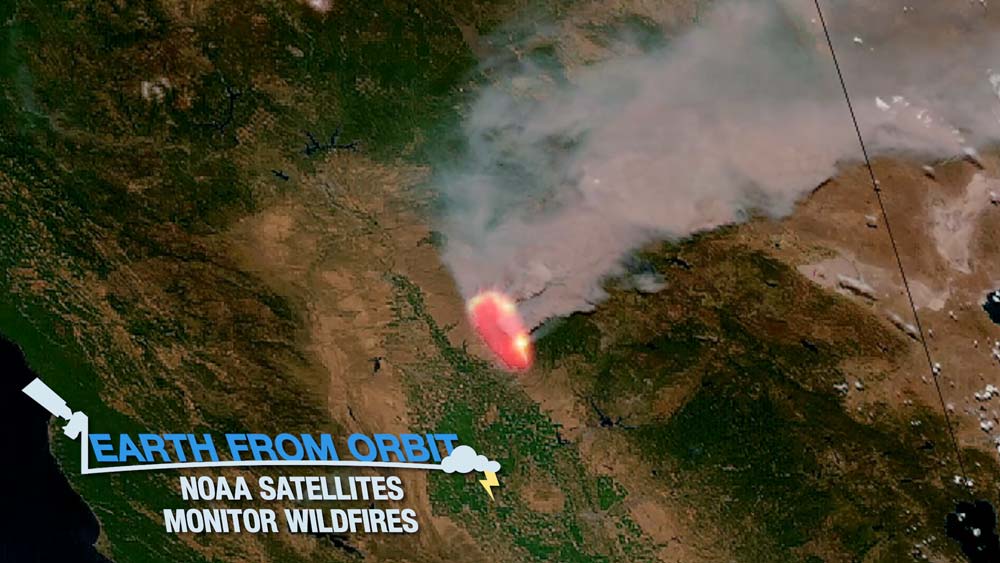
First data from the GOES-19 GMAG. The Goddard Magnetometer (GMAG) instrument, launched onboard NOAA’s GOES-19 satellite on June 25, 2024, is now transmitting magnetic field measurements down to Earth. On July 23, 2024, the GOES-19 GMAG captured a space weather phenomenon known as electromagnetic ion cyclotron waves. These waves play a significant role in controlling the levels of dangerous energetic particles that can cause damage to satellites and harm astronauts. GMAG space weather products can help to improve forecasts of the likelihood of elevated levels of dangerous energetic particles.
-
August 1, 2024 : Earth from Orbit: NOAA Satellite Monitor Wildfires

Roughly 100 wildfires are raging out of control across the western United States and hundreds more are burning in Canada, destroying homes, forcing evacuations, and affecting air quality. NOAA satellites have been closely monitoring these blazes, including California’s Park Fire, which is currently the largest active wildfire in the U.S. The Park Fire, which started on July 24, 2024, is believed to have been ignited by arson. A suspect has been arrested, accused of pushing a burning car into a gully, sparking the blaze. As of Aug. 1, the fire has consumed 392,480 acres across Butte, Plumas, Shasta, and Tehama counties. Fueled by very dry grass and brush, and driven by strong winds, the fire is only 18% contained.
August
-
July 19, 2024 : Earth from Orbit: Severe Thunderstorms Race Through the Midwest
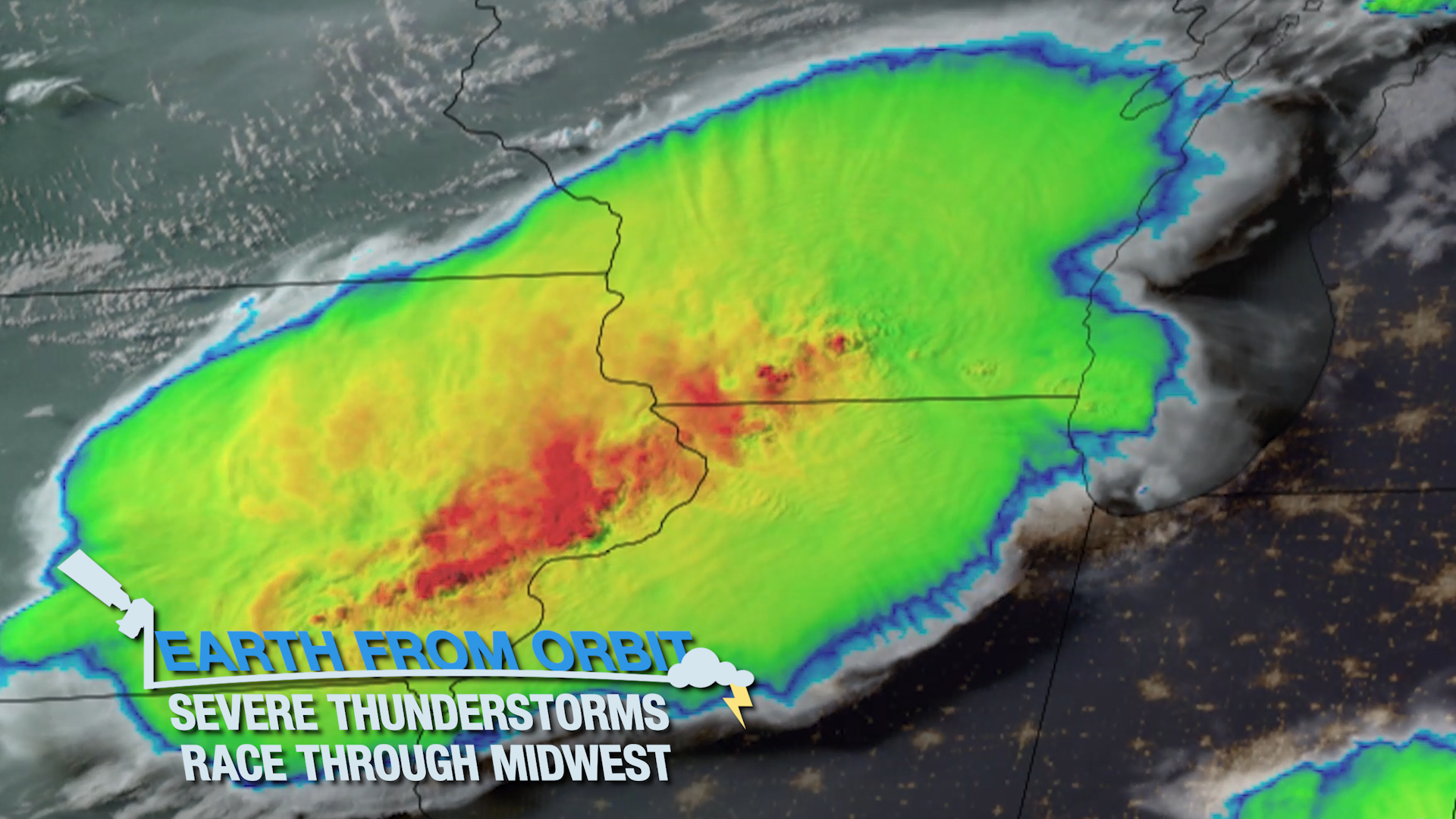
At the end of a humid day in the Midwest, GOES East watched as a derecho ripped through the region on July 15. The storm system developed and moved east across Iowa before reaching Illinois, Indiana and southwest Michigan. The Chicago National Weather Service office confirmed the derecho spawned at least 19 tornadoes in the Chicagoland area. GOES East saw the storms grow in size and intensity over Iowa. The Advanced Baseline Imager onboard GOES East captured infrared imagery revealing the structure of the storm and where it was the most intense. The Geostationary Lightning Mapper on GOES East also measured lightning within the storm system.
-
July 11, 2024 : Earth from Orbit: Hurricane Beryl Kicks Off 2024 Atlantic Hurricane Season
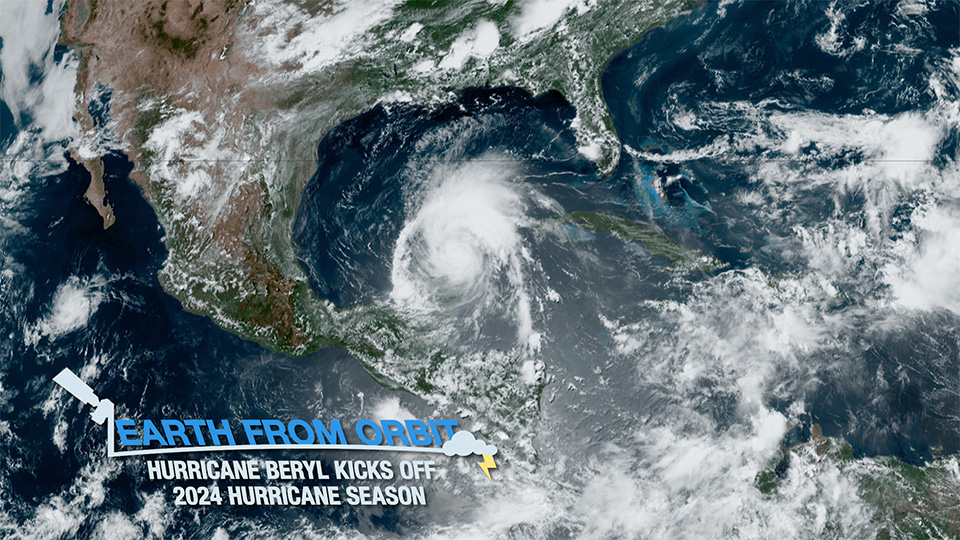
Hurricane Beryl Kicks Off 2024 Atlantic Hurricane Season. Photo credit: NOAA/NASA/CIRA Hurricane Beryl, the first hurricane of the 2024 Atlantic hurricane season, rapidly strengthened to a Category 5 storm unusually early in the year. This explosive strengthening was fueled in part by exceptionally warm ocean temperatures. Beryl first formed as a tropical depression on June 28, 2024, with winds of 35 mph; within the first 24 hours, the storm rapidly intensified into a hurricane with winds of 75 mph. This was the farthest east that a hurricane has formed in the month of June. In the following 24 hours, Beryl underwent another instance of rapid intensification becoming an extremely dangerous Category 4 hurricane. At that point Beryl became the first Category 4 hurricane to form in the month of June. On July 2, 2024, Beryl became the earliest Category 5 hurricane observed in the Atlantic on record and only the second Category 5 hurricane to occur in July.
-
July 7, 2024 : GOES-U Reaches Geostationary Orbit, Now Designated GOES-19
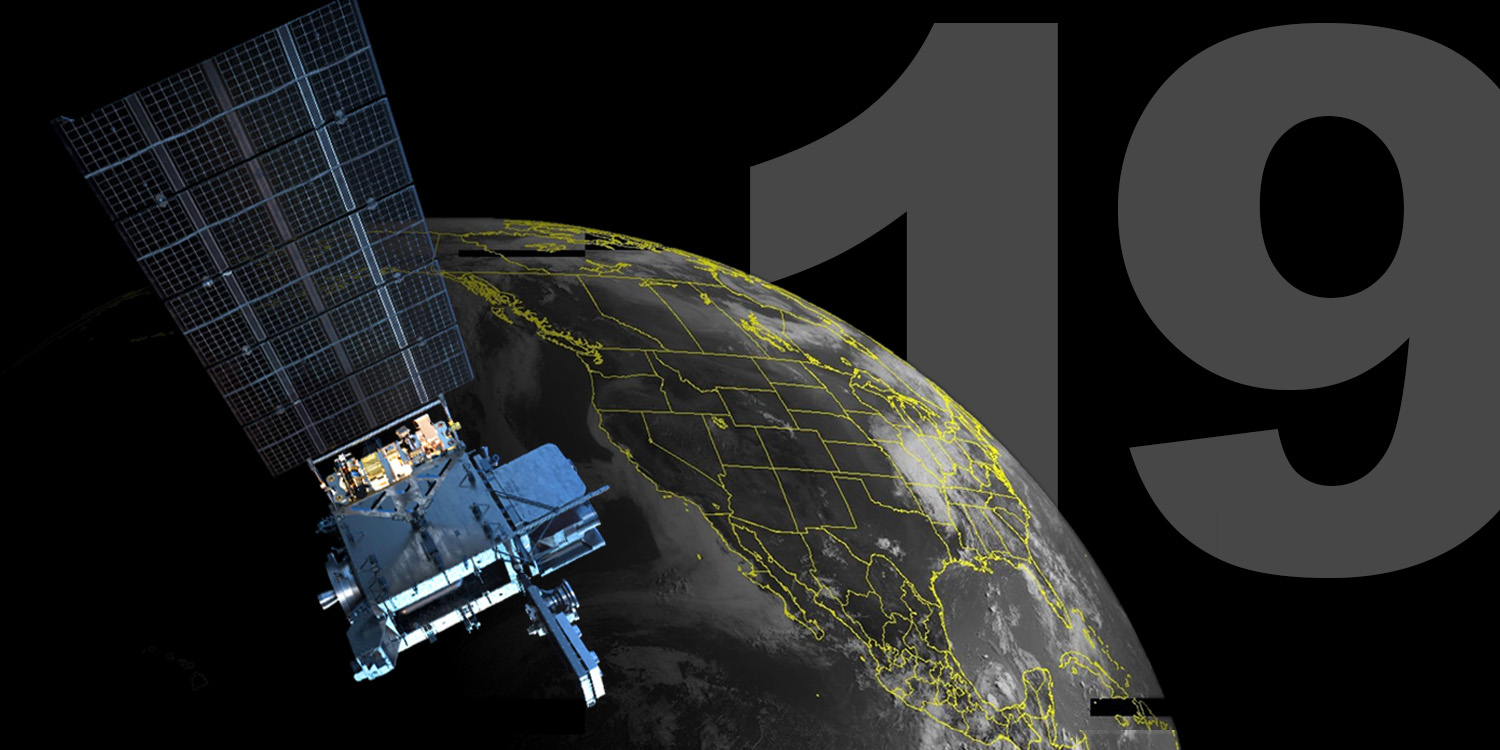
GOES-U Reaches Geostationary Orbit, Now Designated GOES-19 Photo credit: NOAA On July 7, 2024, GOES-U executed its final engine burn, placing the satellite in geostationary orbit 22,236 miles above Earth. Upon reaching this milestone, GOES-U was renamed GOES-19. GOES satellites are designated with a letter prior to launch and a number once they achieve geostationary orbit. NOAA’s GOES-U satellite launched on June 25, 2024, lifting off from NASA’s Kennedy Space Center in Florida. The satellite launched aboard a SpaceX Falcon Heavy rocket from Space Launch Complex 39A. The launch was managed by NASA’s Launch Services Program, based at Kennedy Space Center.
-
June 25, 2024: NOAA’s GOES-U Heads to Orbit for Historic Mission
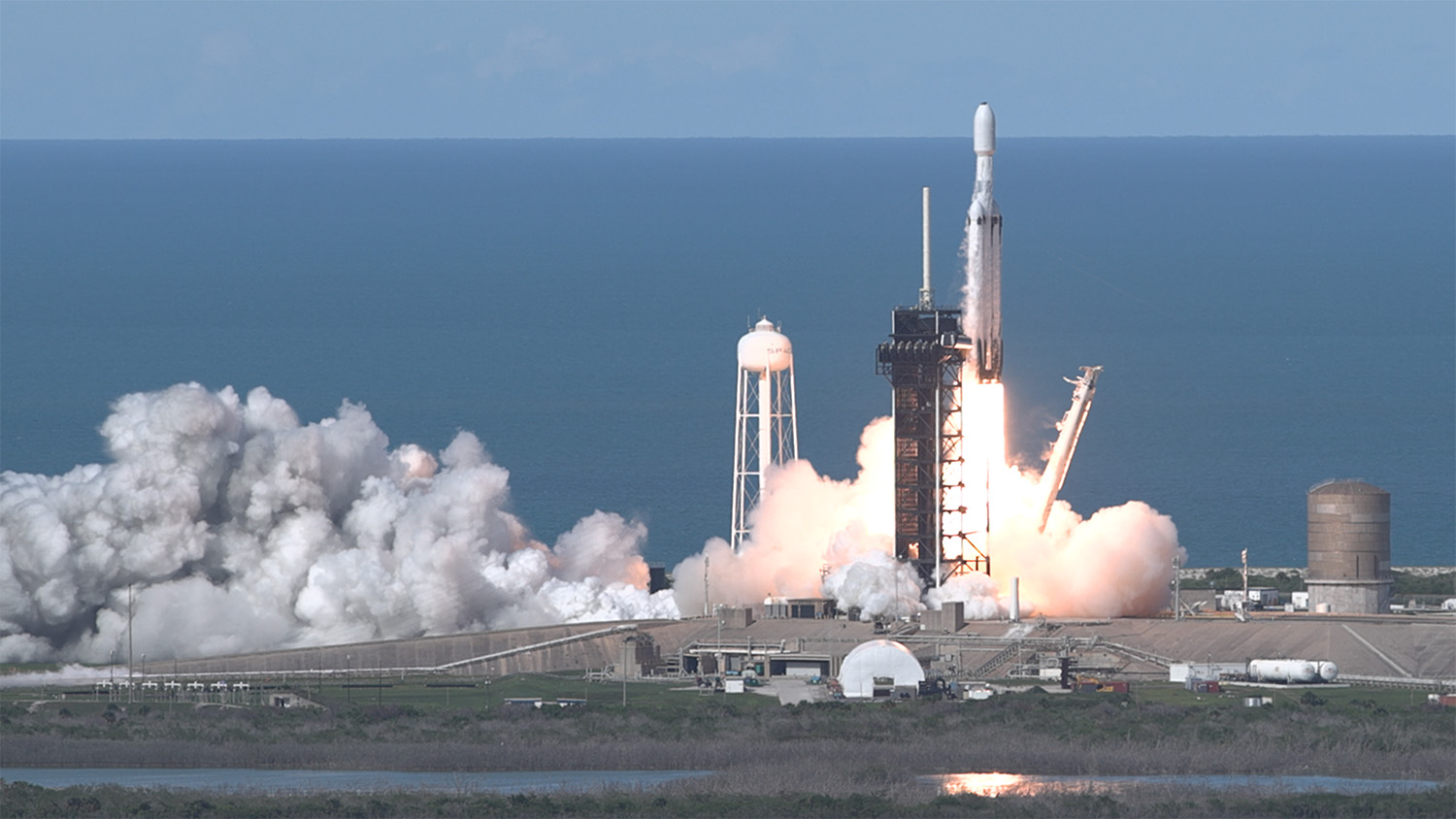
Liftoff of NOAA's GOES-U satellite from NASA’s Kennedy Space Center on June 25, 2024. Photo credit: NASA/Liz Wilk GOES-U, the latest of NOAA’s four advanced geostationary satellites, soared into orbit on a SpaceX Falcon Heavy rocket at 5:26 p.m. EDT from NASA’s Kennedy Space Center in Florida. At 10:18 p.m., mission managers confirmed the spacecraft’s solar arrays successfully deployed, and the spacecraft was operating on its own power. GOES-U will take about two weeks to reach its geostationary orbit. Once there, the satellite will be renamed GOES-19. On board GOES-U is a suite of seven instruments for collecting advanced imagery and atmospheric measurements, providing real-time mapping of lightning activity, and detecting approaching space weather hazards. Also on board for the first time is the compact coronagraph that will observe the sun’s outermost layer, called the corona, for large explosions of plasma that could produce geomagnetic solar storms.
-
June 20, 2024: NASA Completes Flight Readiness Review for GOES-U Mission
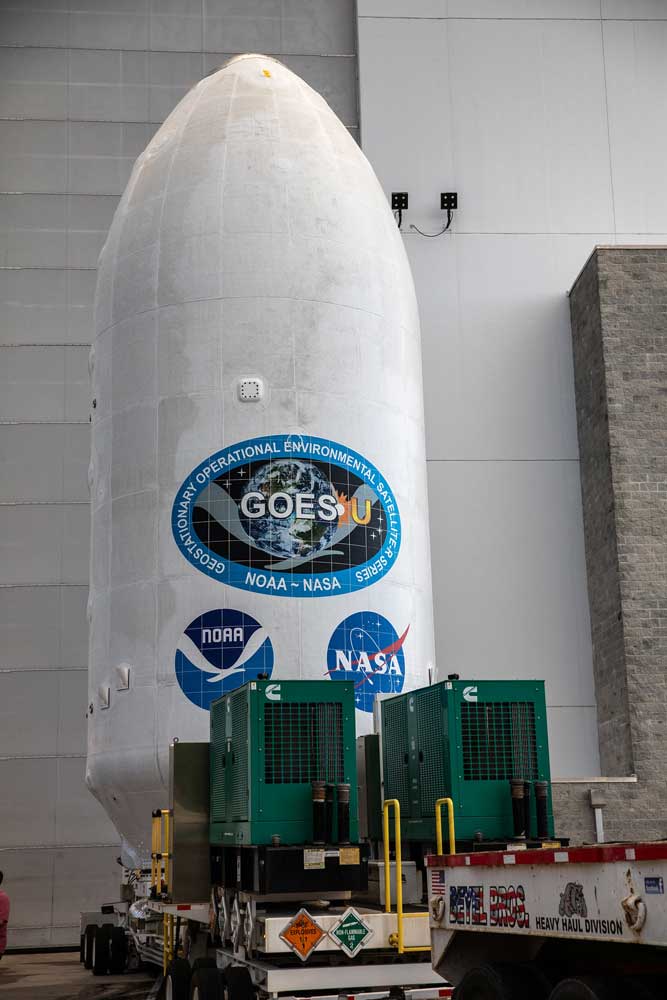
Crews transport NOAA’s GOES-U satellite from the Astrotech Space Operations facility to the SpaceX hangar at Launch Complex 39A at NASA’s Kennedy Space Center in Florida on Friday, June 14, 2024. Photo credit: NASA/Ben Smegelsky NASA, NOAA, SpaceX, and GOES-U mission managers met on June 20 to conduct a Flight Readiness Review at NASA’S Kennedy Space Center in Florida. During the review, teams provided an update on the mission status and certified the readiness to proceed with final launch preparation activities.
-
June 18, 2024: From GOES to GeoXO: Past Highlights to Future Horizons

For nearly 50 years, NOAA and NASA have partnered to develop NOAA’s geostationary satellites as part of the most sophisticated weather-observing, environmental monitoring, and space weather monitoring satellite system in the world. When NOAA’s GOES-U satellite is launched, it will be the fourth and final satellite in the GOES-R Series, and a bridge to a new age of advanced satellite technology – GeoXO. A new video, “From GOES to GeoXO: Past Highlights to Future Horizons,” offers a retrospective of the GOES legacy and a look to the future with GeoXO.
-
June 15, 2024: GOES-U Transported to Launch Complex 39A

Crews transport NOAA’s GOES-U from the Astrotech Space Operations facility to the SpaceX hangar at Launch Complex 39A at NASA’s Kennedy Space Center in Florida beginning on Friday, June 14, 2024, with the operation finishing early Saturday, June 15, 2024. Photo credit: NASA/Ben Smegelsky On June 15, 2024, GOES-U, encapsulated in its protective payload fairing, arrived at NASA Kennedy and SpaceX’s hangar at the spaceport’s Launch Complex 39A. Crews began transporting the satellite from the Astrotech Space Operations Facility in Titusville, Florida, on June 14, with the operation finishing early on June 15. The next mission milestone includes connecting the encapsulated GOES-U to the SpaceX Falcon Heavy rocket that will launch it into space, ahead of rolling the stack out to the launch pad.
-
June 13, 2024: GOES-U Encapsulated in Rocket Fairing

Technicians prepare NOAA’s GOES-U for encapsulation inside payload fairing halves on Thursday, June 13, 2024, at the Astrotech Space Operations facility in Titusville near NASA’s Kennedy Space Center in Florida. Photo credit: NASA/Ben Smegelsky On June 13, 2024, technicians encapsulated the 20-foot-tall GOES-U satellite inside two payload fairing halves in preparation for connecting it to the Falcon Heavy rocket that will launch the satellite into space. During the ascent phase of the launch, the fairing halves will protect GOES-U from aerodynamic pressure and heating. Once GOES-U no longer requires this protection, approximately four minutes after liftoff, the halves will be jettisoned and return to Earth, where SpaceX crews will recover them for use on future missions.
-
June 6, 2024: Prelaunch Media Viewing of NOAA's GOES-U Satellite
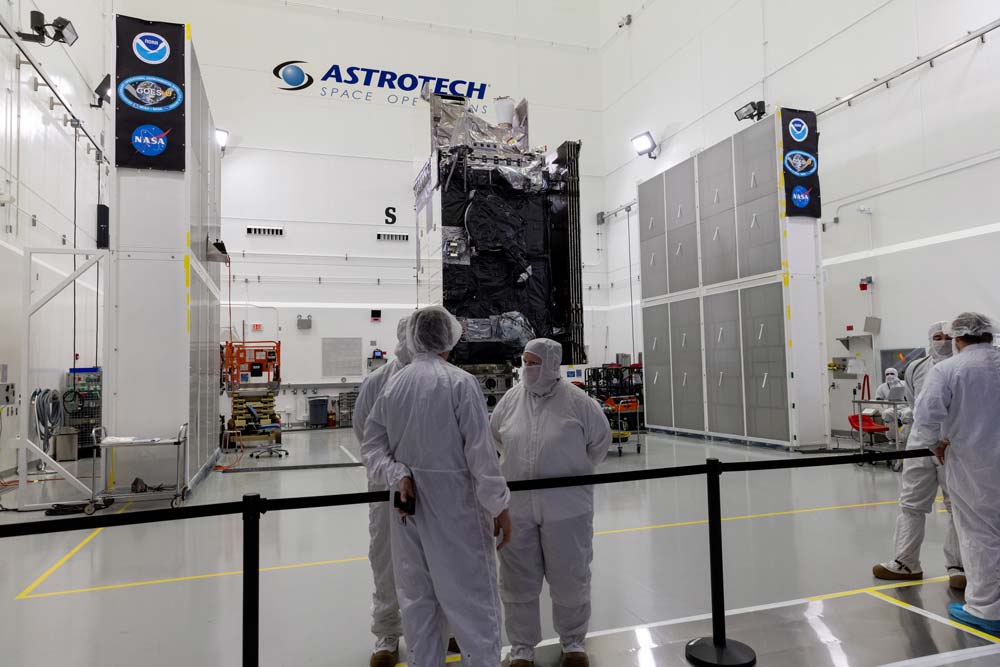
Members of the news media had an opportunity for an up-close look at NOAA's GOES-U satellite on June 6, 2024, inside the Astrotech Space Operations Facility in Titusville, near NASA’s Kennedy Space Center in Florida. Photo credit: NASA/Kim Shiflett On June 6, 2024, NASA and NOAA hosted a media availability to view and photograph the GOES-U satellite at the Astrotech Space Operations payload processing facility in Titusville, Florida. Subject matter experts from NASA, NOAA, Lockheed Martin, and L3Harris Technologies provided a mission overview and answered questions about the satellite’s capabilities to assist meteorologists with predicting, observing, and tracking hazardous weather events on Earth and in space. The opportunity provided media with a last look at the final weather-observing and environmental monitoring satellite in NOAA’s GOES-R Series before technicians prepare it for launch aboard a SpaceX Falcon Heavy rocket. View photos and video of media day.
-
June 4, 2024: GOES-U Art Challenge Selections Announced

Last month, we challenged kids to draw how they imagine lightning looks either within the clouds or striking the ground, from above the sky or from their window. The GOES-U satellite will help scientists “see” lightning and predict where it will strike, helping meteorologists forecast the path of hurricanes, how strong severe thunderstorms can become, and when tornadoes will form. Thank you to everyone who participated! We chose 23 selections to feature.
July
June
-
May 21, 2024: Earth from Orbit: Ocean Color Observations
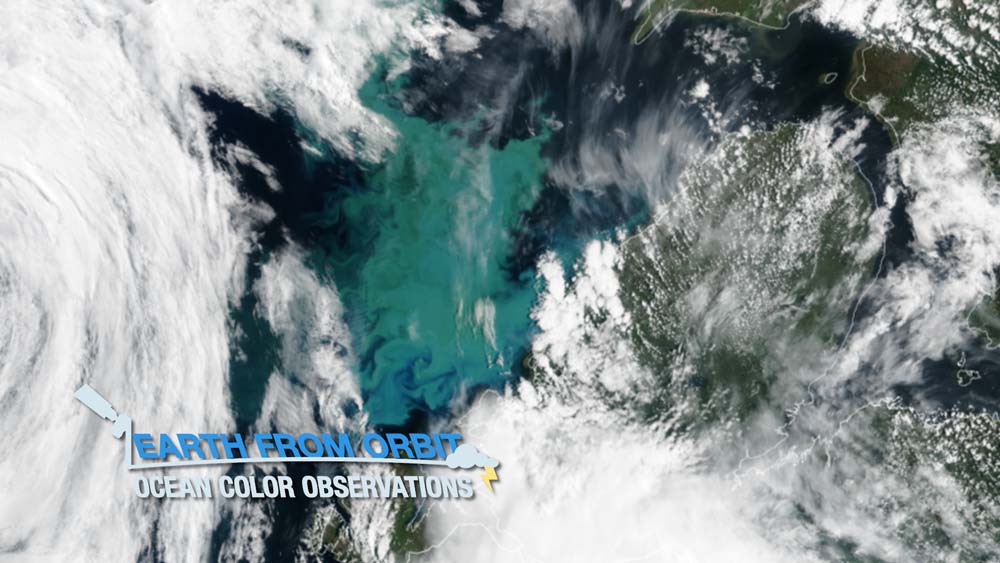
Earth-observing satellites can see many different things, from changing seasons, weather patterns, and land features. From their unique view, satellites can also observe the deep swirling hues and colors of the ocean. With data from NASA’s PACE mission now available, NOAA and NASA are collaborating to develop applications for monitoring various indicators of ecosystem health. NOAA is also preparing for a more advanced Ocean Color instrument (OCX) to be flown on the future GeoXO mission. Having an ocean color instrument on a geostationary satellite such as GeoXO will allow continuous monitoring of a specific area. Additionally, its higher resolution imagery will improve observations of water clarity, chlorophyll concentrations, and help distinguish different types of phytoplankton. GeoXO will begin operating in the early 2030s, taking over after the GOES-R series reaches the end of its operational lifetime.
-
May 1, 2024: GOES-U Art Challenge
Have you ever watched a lightning storm from your window at home? Did you know that scientists can use weather satellites to watch lightning from above, too? On June 25, 2024, NOAA will be launching its latest weather satellite called GOES-U (GOES is short for Geostationary Operational Environmental Satellite). GOES-U will be the fourth and final satellite in the GOES-R group of satellites that keep an eye on Earth’s weather from space. GOES-U will also help scientists “see” lightning and predict where it will strike.
Challenge: Draw how you imagine lightning to look, either within the clouds or striking the ground, from above the sky or from your window. Use any materials you would like – crayons, markers, pencils, pens, aluminum foil, paint, yarn, or anything else you find. The sky's the limit!
The art challenge is open through May 31, 2024. Selected art submissions will appear online and in social media the first week of June. Visit our art challenge webpage for instructions for submitting your art.
May
-
April 19, 2024: Earth from Orbit: Celebrating Earth Day with NOAA Satellites
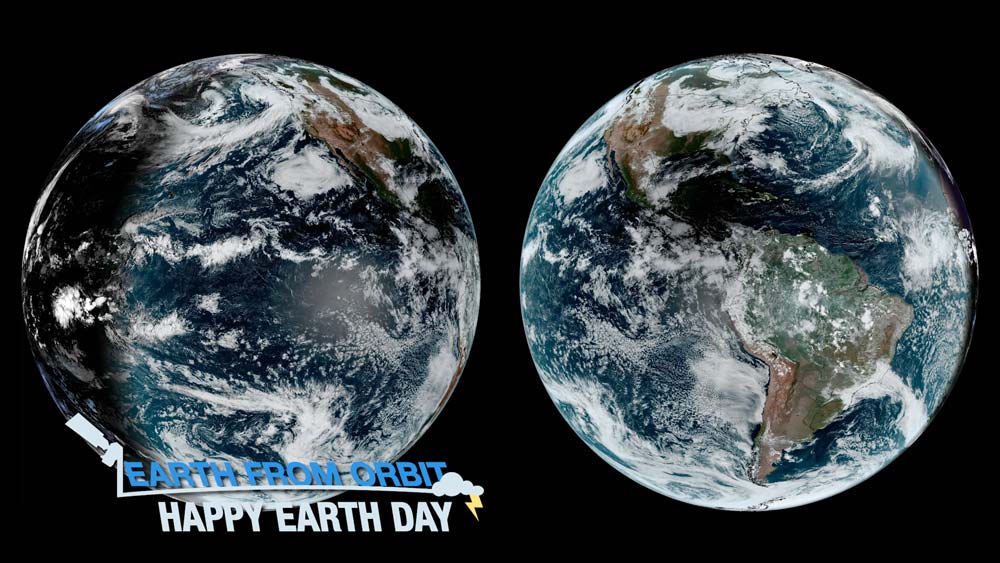
Throughout history, humans have wondered what Earth looked like from above. The advent of satellites changed our perspective dramatically, though early imagery was often blurry and lacked detail. Today, thanks to decades of technological advancements and innovation, the quality and resolution of satellite imagery has significantly improved. Satellites from NOAA and other organizations around the world capture vital information that help us stay safe, while also sharing the beauty of our planet from afar. For us, every day is Earth Day!
-
April 12, 2024: Earth from Orbit: NOAA Satellites View Total Solar Eclipse
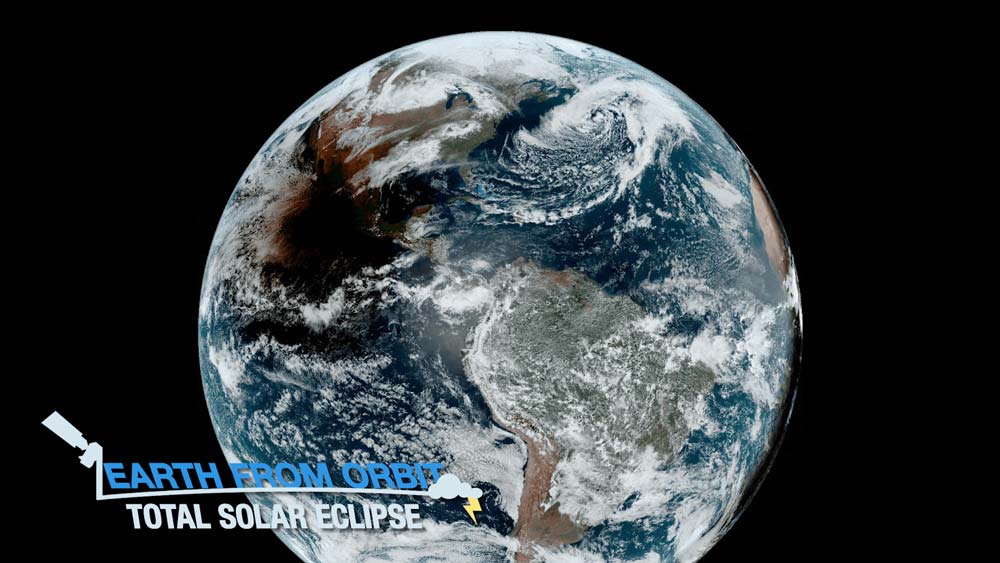
On April 8, 2024, the moon moved directly between the Earth and sun, completely blocking the sun’s light and causing a total solar eclipse. During this event, the moon’s shadow passed over parts of Mexico, the United States, and Canada, and millions of people were treated to a celestial show where the sky darkened as if it were dawn or dusk throughout its path of totality. NOAA satellites play a crucial role in observing solar eclipses and their effects. GOES-16 and GOES-18 watched the moon’s shadow pass over the Earth. The satellites also captured the effects of the eclipse shadow on surface weather, including the drop in land and air surface temperature, and dissipation of clouds. Although solar eclipses happen all over the Earth about twice a year, the next total solar eclipse is not predicted to occur in the United States until March 30, 2033, where it will be seen from northwestern Alaska. Another will occur across parts of Canada, Montana, and the Dakotas on Aug. 23, 2044. However, it won’t be until Aug. 12, 2045, when one will cross the contiguous United States from California to Florida.
-
April 11, 2024: First Quarter 2024 GOES-R/GeoXO Newsletter
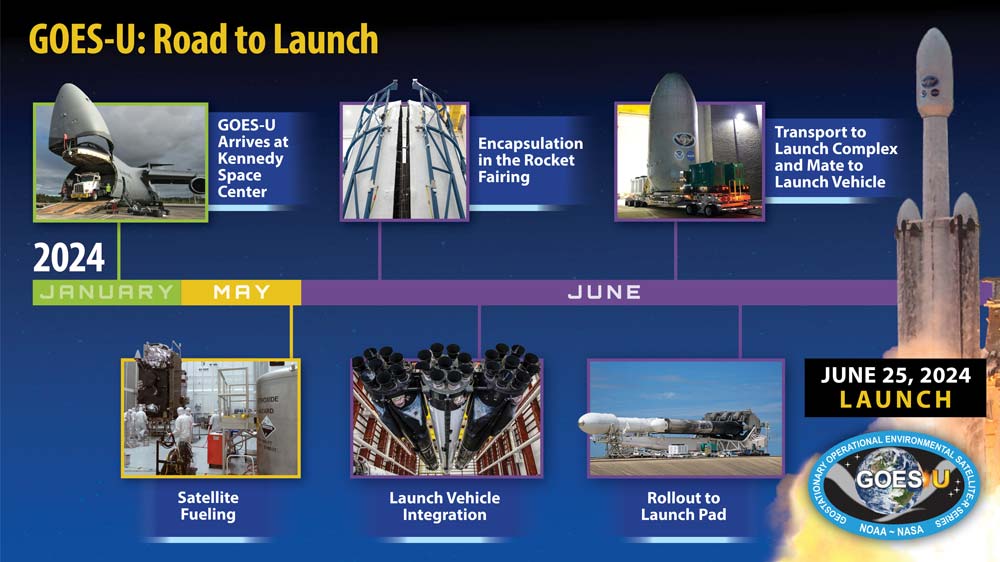
The GOES-R/GeoXO quarterly newsletter for January – March 2024 is now available. Excitement is building for the GOES-U launch, now scheduled for June 25, 2024. SpaceX has repaired the liquid oxygen leak found during testing of the center core booster and launch preparations are back on track. The team is preparing for satellite fueling and encapsulation in the rocket fairing, conducting mission tests and rehearsals, and preparing for the remaining pre-launch reviews. Meanwhile, we are also working hard on GeoXO. The team conducted a successful kickoff meeting for the Sounder and work continues on the Imager. Evaluation boards are busy reviewing proposals for the spacecraft and the OCX, LMX, and ACX instruments. We plan to award the remaining GeoXO contracts by fall.
April
-
March 26, 2024: Earth from Orbit: NOAA Satellites Detect Severe Solar Storm
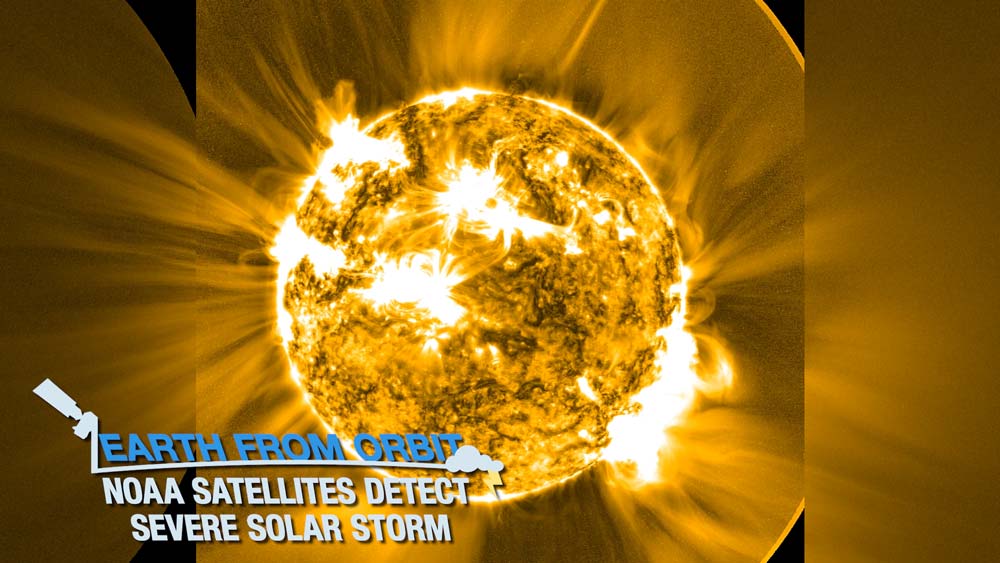
On March 23–24, 2024, NOAA’s GOES-16 and GOES-18 satellites, and others operated by international partners, observed numerous flares erupt from the sun, including a powerful X-class solar flare. Additionally, a surge of extremely hot plasma, known as a coronal mass ejection (CME), raced toward Earth, resulting in geomagnetic storms and auroras. The EXIS instruments onboard both GOES-16 and GOES-18 detected the flare. The satellites’ SUVI instruments viewed the flare and the initiation of the CME. Solar activity is expected to increase as Solar Cycle 25 reaches its peak, which is expected this year. NOAA and partner satellites will continue to watch for increased solar activity.
-
March 26, 2024: GOES-U Mission Overview Video
NOAA is preparing for a milestone satellite launch in 2024. GOES-U will be the fourth and final satellite in NOAA’s latest generation of geostationary operational environmental satellites called the GOES-R Series—the nation’s most advanced weather-observing and environmental monitoring satellite system. Like the three other GOES-R Series satellites already in orbit, GOES-U will provide near real-time, high-resolution imagery that will deliver critical information for weather forecasts, severe weather prediction, lightning detection, and space weather forecasts. GOES U will also carry something new when it launches – a critical space weather instrument called the Compact Coronagraph-1, or CCOR-1. Being able to monitor the sun’s corona helps scientists detect and characterize coronal mass ejections that can spark geomagnetic storms here on Earth– the costliest type of space weather events that can cause widespread damage to power grids, satellites, and communication and navigation systems.
-
March 26, 2024: NASA, SpaceX Target New Launch Date for NOAA Weather Satellite
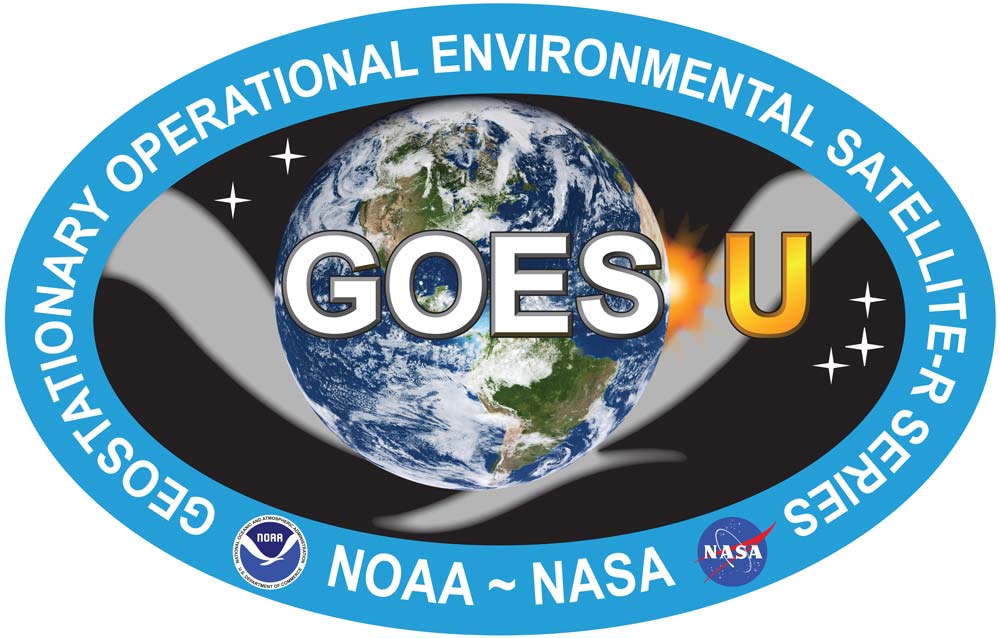
NASA and SpaceX now are targeting Tuesday, June 25, for the launch of GOES-U, the fourth and final satellite in National Oceanic and Atmospheric Administration’s (NOAA) Geostationary Operational Environmental Satellites (GOES) – R Series. The new launch date allowed time for teams to fully repair and test the Falcon Heavy core booster after a liquid oxygen leak was identified during routine new booster testing in February. NASA and SpaceX teams have resumed preparation of the GOES-U launch. GOES-U will launch on a SpaceX Falcon Heavy rocket from Launch Complex 39A at the agency’s Kennedy Space Center in Florida.
-
March 7, 2024: Earth from Orbit: Fires Rage Across Texas Panhandle
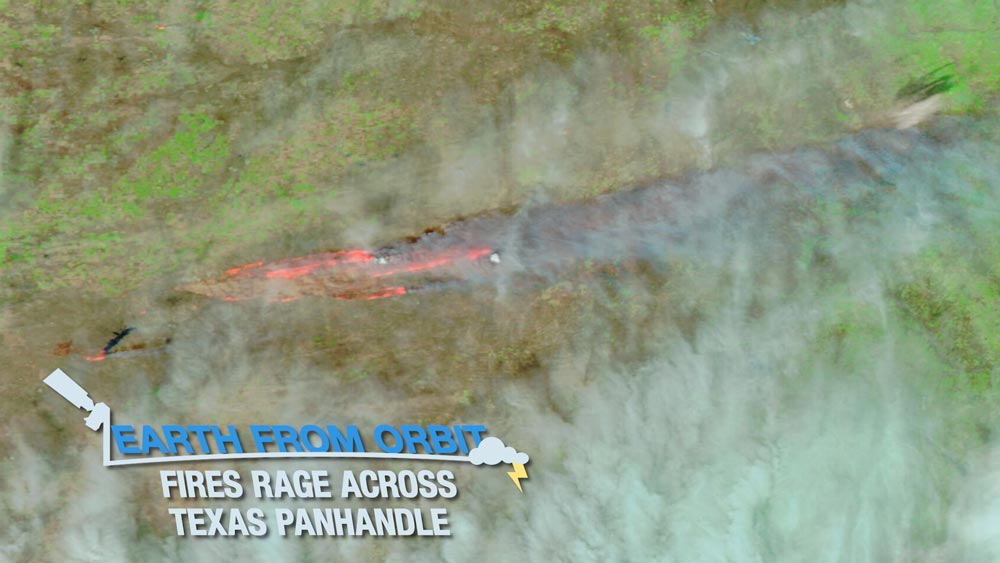
Since late February, NOAA satellites have been tracking wildfires that spread through the Texas Panhandle. The largest wildfire in the state’s history broke out on Feb. 26 and quickly spread, fueled by dry, windy conditions. By Mar. 4, the blaze, known as the Smokehouse Creek fire, had become one of the largest fires in U.S. history. GOES-16 (GOES East) observed these fires in near-real time. This geostationary satellite keeps constant watch over the same geographic area over time, and helps to locate fires, detect changes in a fire’s behavior, and predict its direction. By combining data from multiple channels on its Advanced Baseline Imager (ABI) instrument, both a fire’s hot spot and associated smoke plume can be visualized.
-
March 1, 2024: Earth from Orbit: Great Lakes Ice Reaches Historic Low
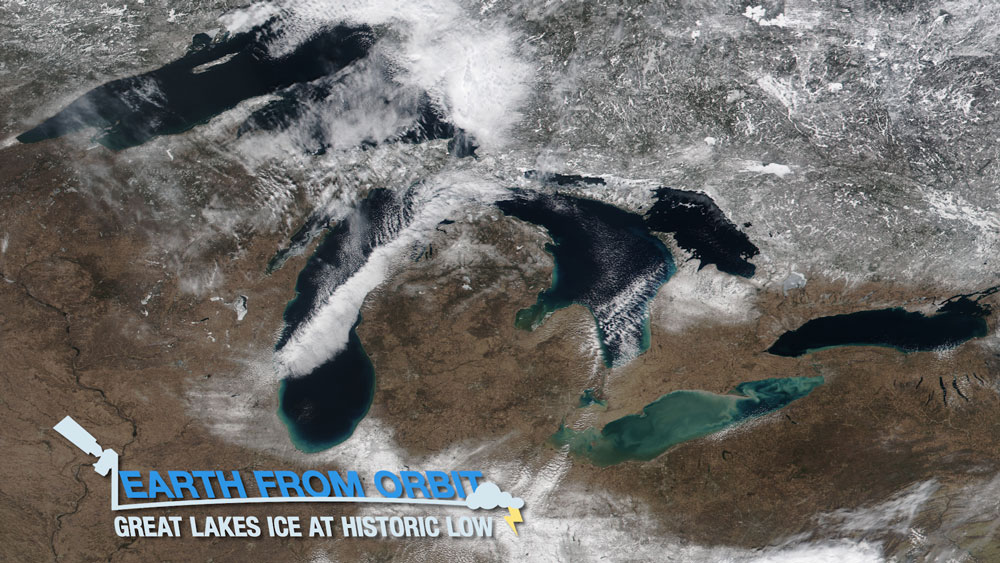
As we leave meteorological winter behind, NOAA satellites have been monitoring the extent of ice coverage in the Great Lakes. The Great Lakes typically see peak ice coverage in late February to early March. Ice plays an important role in the ecosystems, economy, and coastal resilience of the Great Lakes. In 2024, ice coverage reached a historic low. A number of factors have contributed to the historic low this year, such as a strong El Niño and well above-average temperatures this winter. NOAA satellites have observed little ice on the Great Lakes this year.
March
-
February 27, 2024: Launch of GOES-U Satellite Delayed
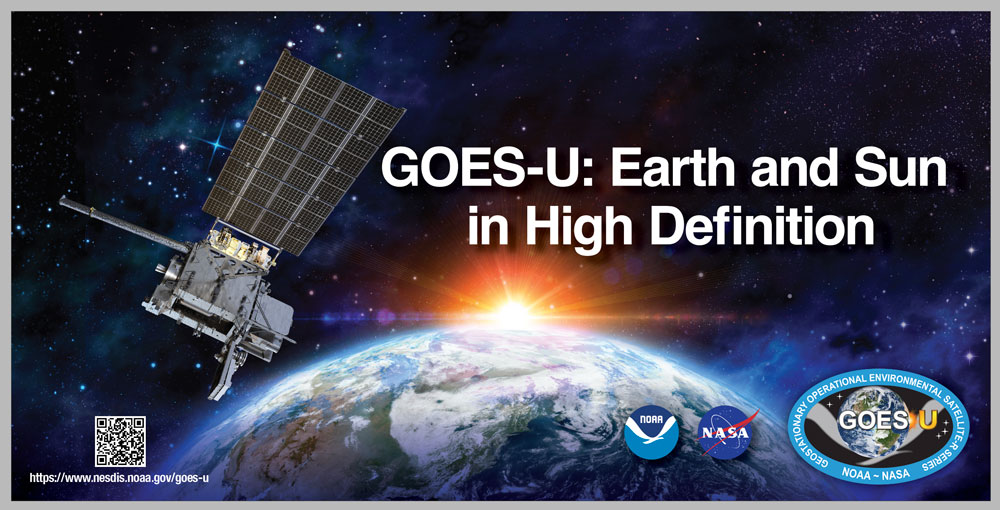
NASA and SpaceX are now targeting no earlier than May 2024 for the launch of NOAA's GOES-U satellite. The new date allows for additional testing and preparation of a new Falcon Heavy center core booster after a liquid oxygen leak was discovered during routine new booster testing. GOES-U is the fourth and final satellite in the GOES-R Series of advanced geostationary satellites.
-
February 8, 2024: Earth from Orbit: GOES-U Arrives at Kennedy Space Center
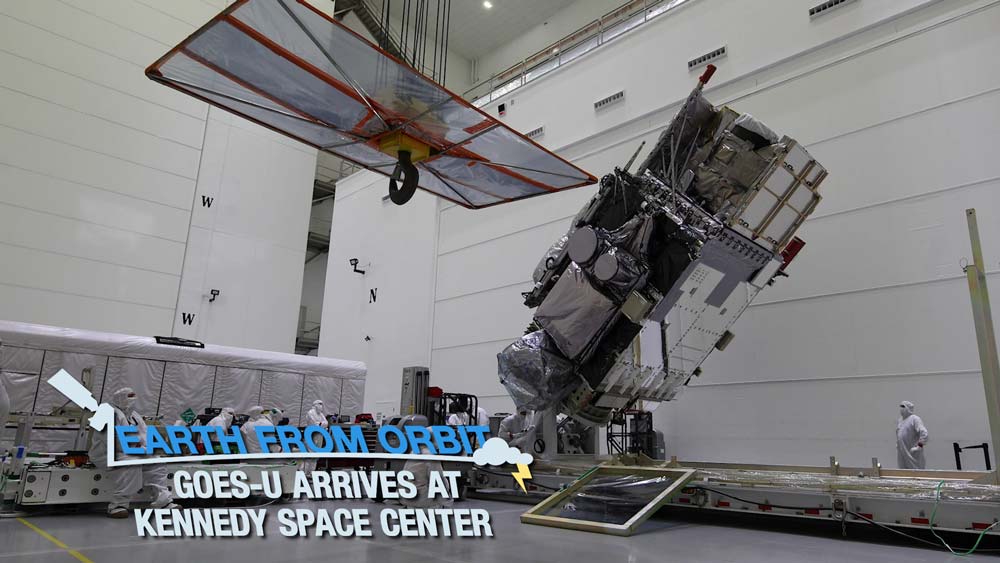
The latest video in the Earth from Orbit series highlights GOES-U’s arrival at Kennedy Space Center last month. After being packed in a high-tech shipping container that acts as a mobile clean room, GOES-U caught a ride aboard a C-5 Super Galaxy aircraft from Buckley Space Force Base in Colorado to NASA’s Kennedy Space Center in Florida. After landing, the satellite was taken to Astrotech Space Operations, where it was removed from its shipping container, inspected, and placed onto a test stand. GOES-U will now undergo final preparations for a spring 2024 launch from Kennedy Space Center, where it will launch aboard a SpaceX Falcon Heavy rocket.
February
-
January 23, 2024: GOES-U Arrives at Kennedy Space Center
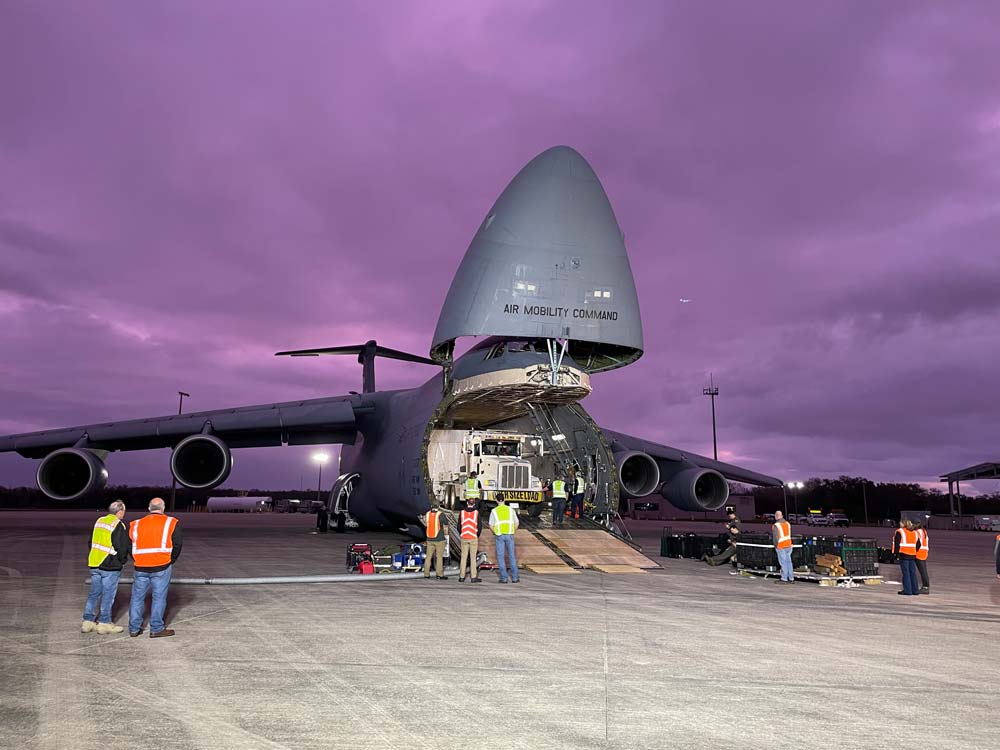
The satellite is in Florida to begin final preparations for its upcoming launch. NOAA’s GOES-U, the fourth and final satellite in the GOES-R Series of advanced weather-observing and environmental monitoring satellites, arrived at NASA’s Kennedy Space Center in Florida on Jan. 23, 2024, to begin final preparations for its upcoming launch. Shipping a satellite is no small feat. GOES-U is the size of a small school bus and weighs over 6,000 pounds! The spacecraft team at Lockheed Martin in Littleton, Colorado, where GOES-U was built, packed the satellite in a high-tech shipping container that protected its sensitive instruments and acted as a mobile clean room during transport. GOES-U was then driven to Buckley Space Force Base in Aurora, Colorado, and loaded on the C-5M Super Galaxy cargo transport that carried it to Florida. GOES-U safely landed at the NASA Launch and Landing Facility airstrip at Kennedy Space Center and was transported to the Astrotech Space Operations spacecraft processing facility in nearby Titusville, where it will go through a series of electrical tests to confirm it is working properly and mechanical configurations to prepare it for launch. GOES-U is scheduled to launch no earlier than April 30, 2024.
-
January 17, 2024: GOES-U: Road to Launch
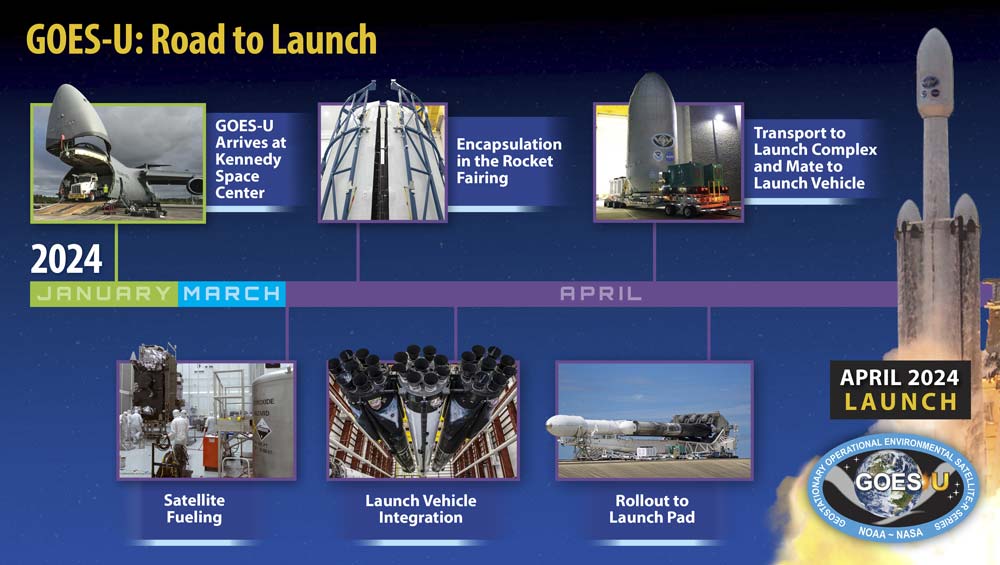
NOAA’s GOES-U, the fourth and final satellite in the Geostationary Operational Environmental Satellites (GOES) – R Series, the Western Hemisphere’s most advanced weather-observing and environmental monitoring system, is entering the final stage of preparations before liftoff. NASA and SpaceX are targeting no earlier than April 30 for the launch of GOES-U on a Falcon Heavy rocket. The GOES-U team has spent years building the instruments and spacecraft, integrating all the satellite’s components, and conducting rigorous testing to ensure it can withstand the harsh launch conditions and successfully take up residence 22,236 miles above Earth. Before that happens, the spacecraft must complete several final milestones. Learn more about GOES-U’s road to launch.
-
January 11, 2024: Fourth Quarter 2023 GOES-R/GeoXO Newsletter

The GOES-R Program and L3Harris celebrated the GOES-R ground system development contract close-out The GOES-R/GeoXO quarterly newsletter for October – December 2023 is now available. Happy New Year! It’s a very exciting time for the GEO Program! We are gearing up to launch the last of the GOES-R Series satellites. GOES-U will soon ship to Kennedy Space Center and begin final preparations for its planned launch in April. GeoXO also had a successful quarter. The final development RFP, for the ACX instrument, was released in October. Evaluation boards are busy reviewing proposals for the spacecraft and the OCX, LMX, and ACX instruments. GOES-16 and GOES-18 continue to provide critical data to keep us informed of and safe from severe weather and environmental hazards. The program is looking forward to more GEO successes in 2024!
-
January 4, 2024: Earth from Orbit: 2023 Satellite Imagery: A Year in Review
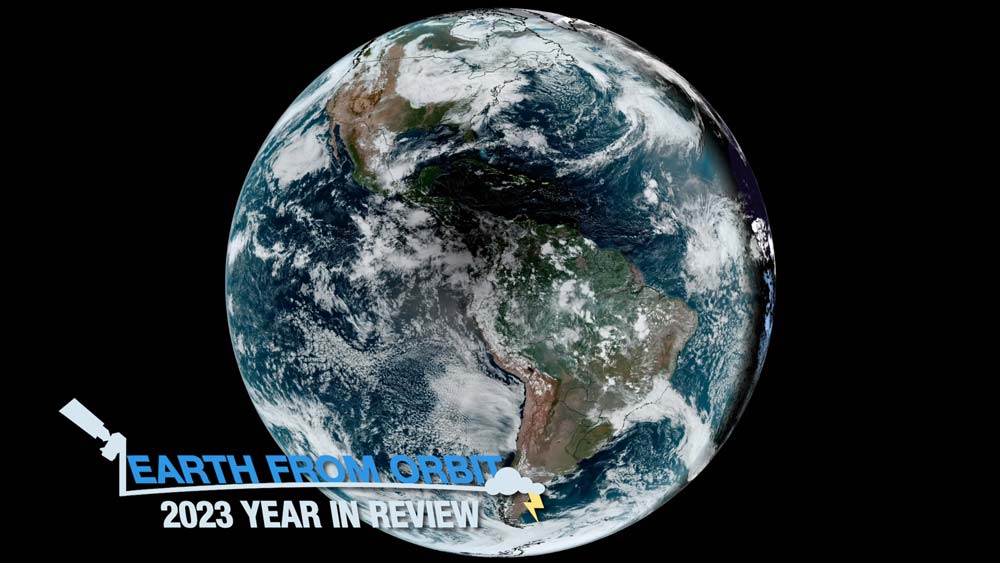
NOAA satellites see our planet from a unique and captivating perspective. Every year, they capture the beauty and wrath of Mother Nature unfolding beneath them—devastating hurricanes, raging wildfires, erupting volcanoes—as well as the changing seasons, ocean color, nighttime lights, and more. The view of NOAA satellites isn’t just limited to Earth; they also capture images of our moon and the sun as we navigate our cosmic journey. As we head into the new year, take a look back at some satellite imagery highlights from 2023.
January
MORE NEWS
